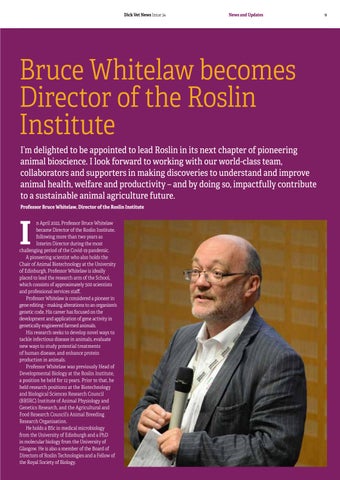

Welcome
Professor David Argyle Head of School
As we came out of lockdown this year and left behind us many of the challenges of the Covid-19 pandemic, it has been wonderful to see the campus buzzing once more as staff and students reignite our tangible Dick Vet community. As many of you will know, we started this year with the sad news that our Head of College Professor Moira Whyte had been taken ill. As a result, I was asked to take on additional leadership of the College as an interim measure. I am hugely grateful for the support of my colleagues across the School and College who enabled me to juggle two roles during this time, and incredibly pleased to be able to report that Moira has now made a positive recovery. Moreover, despite the challenges we faced in these difficult circumstances, our work continued to deliver in support of our excellent reputation in research, clinical, education and outreach.
As you will read in this issue, this year we welcomed Professor Bruce Whitelaw as Director of the Roslin Institute, and under his leadership our research programmes have thrived. Not least among the year’s achievements was the news that the School’s joint submission with Scotland’s Rural College (SRUC) to the Research Excellence Framework (REF) was once again ranked first in the UK for research power. This augurs well for our future, and our future funding. In this, I thank all of our researchers on campus and our collaborative partners for the work they do to create real-world impact in the wellbeing of animals and humans.
We have pushed forward a strong agenda in research, focused on sustainable agriculture, infectious diseases, and animal and human health, with some major initiatives nationally
and internationally. In November, Bruce and I had the pleasure of attending the launch of the second round of funding for the Centre for Tropical Livestock Genetics and Health (CTLGH) in Nairobi. This partnership with the International Livestock Research Institute (ILRI) and SRUC is funded by the Bill & Melinda Gates Foundation and the UK Foreign, Commonwealth and Development Office (FCDO). This was a wonderful opportunity to review progress and to look to the future in terms of how the School supports development through livestock improvement. Our research teams have also played a major role in advocacy this year, with contributions to debates on subjects such as gene editing technology in livestock, and the influence of agriculture on climate change and mitigation strategies.
Our clinics continue to thrive under the leadership of Dr Sue Murphy, who has transformed our clinical hospitals with the growth of new services such as ophthalmology, in addition to recruitment of key colleagues into existing services. We have still faced challenges associated with Covid-19, but we have an amazing clinical team on campus whose dedication to their clinical and teaching work has been faultless, and maintained our high standards in often difficult circumstances. As ever, we offer great service to our first opinion customers and referring vets, and a fantastic clinical experience to our students. With colleagues in SRUC and across Scotland, we have further developed our unique elective opportunity for students to experience remote and rural practice, which has been a huge success.
As ever, I am incredibly proud of and grateful to everyone involved in teaching and support, who have contributed to excellence
I am delighted to be able to share with you a flavour of the incredible work our colleagues and students have undertaken in 2022 in this Dick Vet News.
in innovation over the past year. Despite the complexities of face-to-face teaching and clinical contact, we once again graduated an amazing cohort of new veterinary surgeons in July. The personal commitment of our staff and students cannot be overstated. We have learned a lot from teaching during the pandemic, and many of the new ideas developed during this period are now being incorporated into our thinking around curriculum development. While this was an amazing team effort, I would personally like to thank Professor Susan Rhind, our Head of Education, who skilfully navigates our teaching. We are delighted again to be recognised as the highest scoring school in the University in the National Student Survey. Equally, we were once again ranked first in the UK for Veterinary Medicine in the Guardian
The infrastructure we have built at our Easter Bush Campus has enabled us to develop one of the strongest veterinary schools in the world. Our bicentenary is 2023, and we are planning some amazing events that we hope you will be able to join us for.
League Table 2022. This is testament to the excellence in teaching and student support we provide. In October we undertook our sevenyear international accreditation visit from the RCVS, AVMA, SAVA and AVMB. Everyone in the School contributed to this, but I would like to thank Cat Eastwood, Deputy Head of School for Operations, who led and brought all of this together. We will know the outcome in early 2023, but in the meantime are very pleased with how the visit went and our ability to demonstrate our impressive student offering to the panel.
As ever, our sights are now firmly set on the future as we follow our ambitious fiveyear strategic plan, including the continued development of new initiatives such as the Centre for Aquaculture Genetics and Health, a new Centre for Epidemiology and a plan to create a Division of General Practice. We also continue with our ambitious plans for a new first opinion practice in Midlothian to support the new Division and again further improve our student experience and clinical offering. We recently opened our first outreach centre in Edinburgh, called All4Paws, to support homeless and vulnerably housed people and their pets, and will formally launch this in the new year.
The infrastructure we have built at our Easter Bush Campus has enabled us to develop one of the strongest veterinary schools in the world. Our bicentenary is 2023, and we are planning some amazing events that we hope you will be able to join us for. Keep an eye on our website for more details. In the meantime, I hope this edition of the Dick Vet News will give you a flavour of the ambition and excitement that underpins our thriving community.
‘I took the photo a few years back while hiking up a mountain in Switzerland. It was actually the middle of summer at the time (not that’d you’d know from the photo) so I was feeling hot and tired. I turned around and saw this bird of prey circling against the backdrop of the glaciers topping the mountains and grey clouds, a little way from the one we were going up. I found it so peaceful and calm observing the bird and it’s exactly those kind of moments that make a good hike so worthwhile, I’m just glad I happened to have my camera with me to catch it.’
- Helena Charlton, intercalating student.

Year In Review
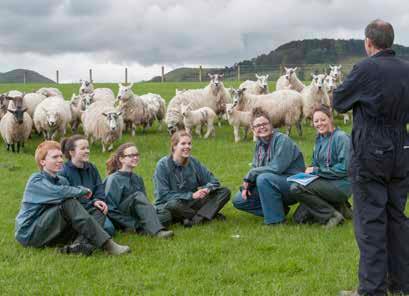
Jan
Apr
Jul
Oct
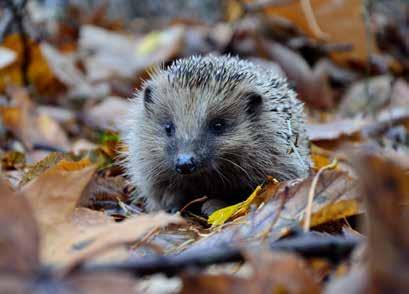
Enzyme therapy shows promise for childhood dementia. Page 20.
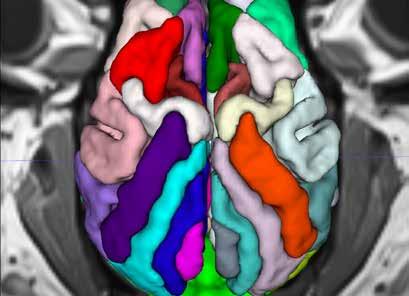
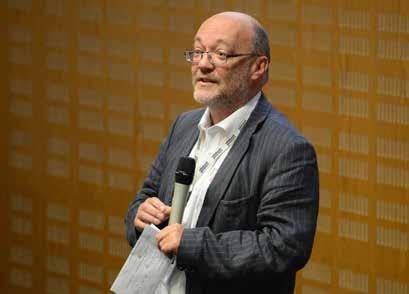

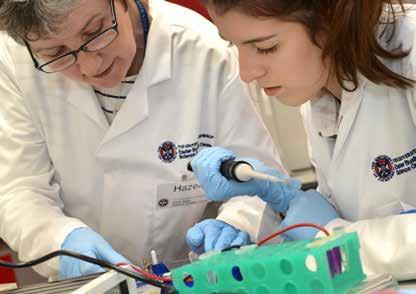
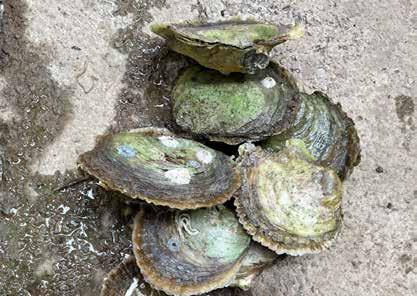

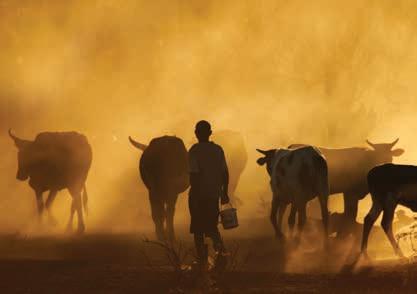
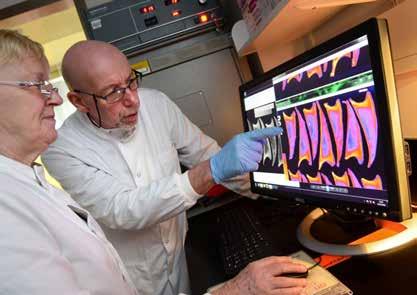
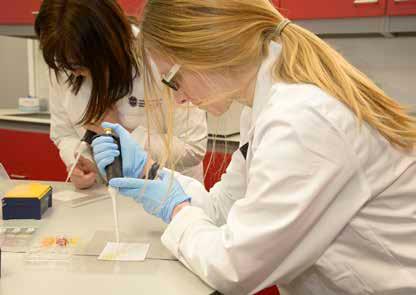

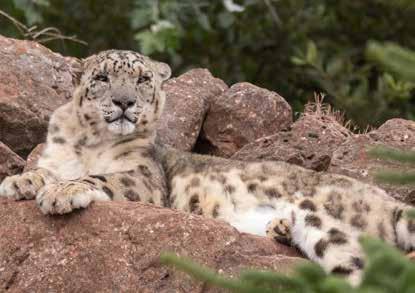
School REF Results highlight research excellence
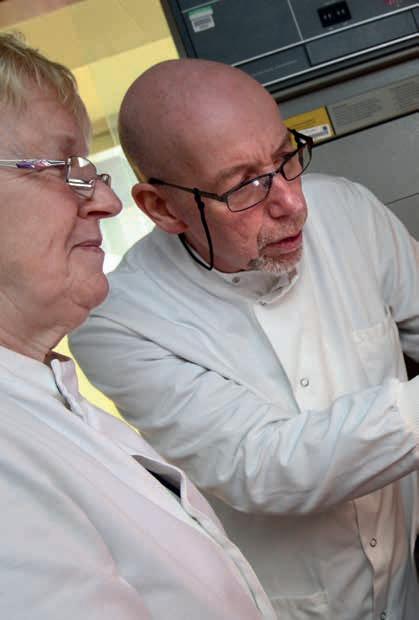
The Royal (Dick) School of Veterinary Studies is an outstanding environment in which to conduct scientific research, enabling outputs with a significant impact on wider society, according to the latest national assessment of higher education institutions.
In a joint submission to the latest UK Research Excellence Framework exercise in 2021, research at the Royal (Dick) School of Veterinary Studies (R(D)SVS) and Scotland’s Rural College (SRUC) was ranked first in the UK for agriculture, food and veterinary sciences, by combining Times Higher Education’s ratings for each institution.
The judgement, based on the quality and breadth of research, maintains our joint position as the strongest provider in these subject areas. Our research environment was classified to be 100 per cent world leading or internationally excellent for agriculture, food and veterinary sciences research.
The submission was also assessed as being 100 per cent world leading or internationally excellent in terms of the impact its research work has on wider society.
Overall, the University of Edinburgh has been ranked fourth in the UK based on the quality and breadth of its research, known as research power, and is Scotland’s top-ranked institution.
The University of Edinburgh’s submission to the 2021 Research Excellence Framework exercise was among the largest and most comprehensive in the UK. Around 2,800 individuals - all of the University’s academic independent researcher workforce - had their research assessed.
Nearly 90 per cent of the University’s research activity is assessed as being in the highest categories of 4 star – classified as world-leading – or 3 star – internationally excellent.
“This excellent result reflects the talent and commitment of all who contribute to creating and upholding a worldclass, creative, collaborative research environment. I am incredibly grateful to everyone involved in enabling us to maintain our leading position in research in agriculture, food and veterinary sciences.”
Professor David Argyle, Head of the Royal (Dick) School of Veterinary Studies and Acting Head of the College of Medicine and Veterinary Medicine
“This fantastic result is a testament to the talent, ingenuity and sheer hard work of our staff. It shows that our world-class research is playing its part in making the world a better place in a way that few places – with a combination of the brightest minds, the most cuttingedge facilities, powerful partnerships, and a commitment to tackling sticky problems from all angles – can do in the way that Edinburgh can. This success is shared with our industrial, charity and philanthropic supporters with whom we have collaborated to maximise the impact of our work locally and globally.”
Professor Peter Mathieson, Principal and Vice Chancellor of the University of EdinburghDick Vet takes home Gold at University Sustainability Awards
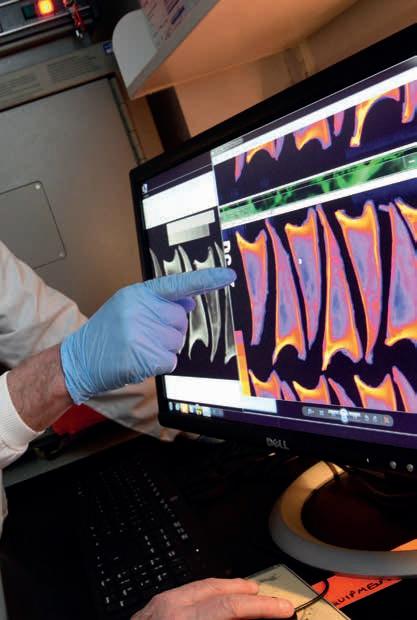
Our Easter Bush Campus has achieved another Gold Office Award in the 2022 University of Edinburgh Sustainability Awards. This is the tenth year that the campus has received an Office Award, and the eighth year in a row it has achieved Gold status.
This impressive achievement is due to the multitude of innovative projects introduced by the Easter Bush Campus’ Sustainability and Social Responsibility Committee. This group has representation from staff and students across all campus activities, including teaching, research, clinical, professional and technical services, and aims to ensure that the Easter Bush Campus is a beacon of good practice in Sustainability and Social Responsibility.
Working collectively with staff and students across the campus, the initiatives introduced by the committee and its partners have helped the School conserve resources, reduce our carbon footprint and support local biodiversity.
We are in the final stages of commissioning a solar farm, which will provide 15% of the campus electricity consumption going forward. We have also introduced multiple electric vehicle charging points and other sustainable travel initiatives.
In addition to a campus apiary, Easter Bush offers garden allotments for staff and students to manage. We are also in planning stages for a physic garden, which will be a learning aid for our students, staff and visitors, and contribute to the biodiversity of the wider Dick Vet garden.
We have also introduced a range of initiatives to reduce energy, plastics, packaging and water use across labs, offices, hospitals and clinics as well as multiple recycling points.
Multiple Student Experience Grants have supported ecological awareness projects on campus. Litter picking initiatives and participation in the Hedgehog Friendly Campus Awards, as well as a raptor survey in conjunction with the Undergraduate Conservation Medicine Society, have also enabled us to protect our local biodiversity.
In October 2022, the University of Edinburgh was awarded the top spot in the UK and fourth globally in a new measure of sustainable educational institutions, the QS Sustainability Rankings. The QS World University Rankings provide leading world league tables for the sector, but this is the first year they have ranked sustainability.
Public dialogue explored views on gene editing
Apublic dialogue on genome editing in farmed animals could help to shape responsible research and innovation as the technologies develop.
The consultation, which involved around 80 members of the public between May and July 2022, was led by the Biotechnology and Biological Sciences Research Council (BBSRC), part of UK Research and Innovation (UKRI), and the Nuffield Council on Bioethics, with the support of UKRI’s Sciencewise programme.
It was overseen by an advisory group involving scientists from the Roslin Institute, chaired by Sarah Mukherjee MBE, CEO of the Institute of Environmental Management and Assessment and a former BBC Environment Correspondent, and run by Basis Social, a social research consultancy.
The dialogue followed the publication of a Nuffield Council on Bioethics report on the social and ethical issues associated with genome editing and farmed animal breeding. This report recommended early, open and informed dialogue in anticipation of gene editing being introduced into food and farming systems.
Participants felt there should be wider public debate to inform research and innovation, and expressed a desire for clarity around the Government’s plan for the future of food and farming. Regulation was seen to be an important element of ensuring that work in this area improved welfare for animals, rather than just benefitting producers.
Gene editing is the precise, targeted alteration of DNA in a living cell. It enables changes, which aim to secure certain physical traits in new generations of farmed animals, to be made faster and with greater precision than other types of genetic technologies or traditional breeding methods.
In the UK, genome editing techniques are not currently used in breeding animals that are sold for food, but research in this area is advanced, and some gene-edited animals have been approved for consumption in other parts of the world.
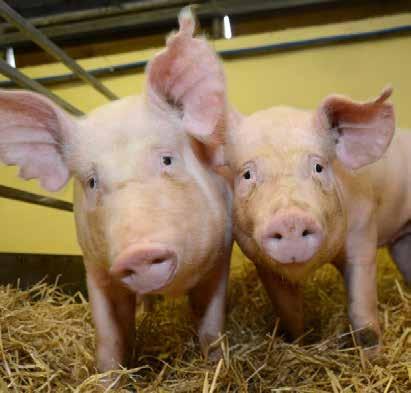
“The Roslin Institute is a world leader in gene editing of farmed animals, with a Large Animal Research and Imaging Facility that significantly enhances our ability to conduct comprehensive studies towards better animal health, welfare and sustainability. This public dialogue is fundamental to understand how people see these technologies and their impact on the future of food.”
- Dr Chris Proudfoot, Large AnimalRoslin global annual impact approaches £20bn
Areport by BiGGAR Economics has outlined the contribution of the Roslin Institute to the local, national and international economies, assessing its value at almost £20 billion a year.
Research carried out at Roslin contributes to the global economy largely through productivity improvements in agriculture and aquaculture, according to the report. This figure includes a contribution of almost £325 million to the UK economy, more than £80 million to Scotland and almost £50 million to the local economy.
Furthermore, Roslin’s work supports more than 1,600 jobs worldwide, including 1,325 in the UK and more than 1000 in Scotland. For every £1 of public funds received, Roslin generates £3.40 in Scotland and £13.50 for the UK.
The Institute is a highly impactful organisation, successfully delivering its aim to enhance the lives of animals and humans through high quality research in animal biology, the authors say. The report considers long-term productivity gains from its research together with economic benefits associated with Roslin’s operational activities and impact from its business support.
Research impact is enabled through commercialisation of the Institute’s fundamental discoveries via strategic relationships with global genetics and animal health companies. Operational impact comes through direct turnover and employment, by local staff and student spending and through expenditure on physical capital and research infrastructure. Business support enables the transfer of research and knowledge through its interactions with businesses and training of postgraduate students.
In combination, the Roslin Institute’s projected global impact by 2024/25 from sector, operational, and business support is expected to reach £24.3bn, supporting 1,711 jobs. By 2029/30, this impact is projected to increase to a global impact of almost £30bn, supporting 1,923 jobs.
Academic Liaison, Roslin Institute
Economics, Economic Impact of the Roslin Institute
The Roslin Institute is an innovation system in its own right, creating impact because of the way knowledge, technology, and information flow through the system, among people, enterprises, and external institutions. It is built on the foundations of world-leading research and without this fundamental research there simply would be no economic impact.
BiGGAR
Bruce Whitelaw becomes Director of the Roslin Institute
I’m delighted to be appointed to lead Roslin in its next chapter of pioneering animal bioscience. I look forward to working with our world-class team, collaborators and supporters in making discoveries to understand and improve animal health, welfare and productivity – and by doing so, impactfully contribute to a sustainable animal agriculture future.
Feature I
n April 2022, Professor Bruce Whitelaw became Director of the Roslin Institute, following more than two years as Interim Director during the most challenging period of the Covid-19 pandemic.

A pioneering scientist who also holds the Chair of Animal Biotechnology at the University of Edinburgh, Professor Whitelaw is ideally placed to lead the research arm of the School, which consists of approximately 500 scientists and professional services staff.
Professor Whitelaw is considered a pioneer in gene editing – making alterations to an organism’s genetic code. His career has focused on the development and application of gene activity in genetically engineered farmed animals.
His research seeks to develop novel ways to tackle infectious disease in animals, evaluate new ways to study potential treatments of human disease, and enhance protein production in animals.
Professor Whitelaw was previously Head of Developmental Biology at the Roslin Institute, a position he held for 12 years. Prior to that, he held research positions at the Biotechnology and Biological Sciences Research Council (BBSRC) Institute of Animal Physiology and Genetics Research, and the Agricultural and Food Research Council’s Animal Breeding Research Organisation.
He holds a BSc in medical microbiology from the University of Edinburgh and a PhD in molecular biology from the University of Glasgow. He is also a member of the Board of Directors of Roslin Technologies and a Fellow of the Royal Society of Biology.
Campus to host secondary school with focus on STEM
Anew Science, Technology, Engineering and Mathematics (STEM) Centre of Excellence secondary school will be built at Easter Bush by 2026.
The University of Edinburgh and Midlothian Council have agreed plans to build the school, which will replace nearby Beeslack Community High School.
The facility will address a projected increase in pupil numbers from expanding communities in local areas, accommodating 1200 pupils, with capacity to expand to 1600. The facility will also have a dedicated learning space for children with additional support needs and community facilities appropriate for local needs, with indoor and outdoor sports facilities.
The building will be designed to have very low carbon emissions. Its green building standards and central location, which will encourage cycling and walking, will help the council towards its goal of becoming carbon neutral by 2030.
Pupils use big data to monitor bee health
In summer 2022, pupils and teachers worked with scientists from the Roslin Institute to explore how to use data to predict the health of their school’s honeybee colony.

The project, led by our Public Engagement team, helped establish a smart monitoring system with pupils at Kelso High School to collect data from their apiaries every five minutes, every day, for several weeks.
Real-time data from the hive provided information on temperature, humidity, and sound frequency in the colony. The pupils also analysed bees to test if they were affected by a common parasite, called Nosema, by using DNA and microscope analysis, with support from Roslin scientists and the Public Engagement team.
Their experiments enabled the pupils to better understand honeybee health and the role of science in beekeeping, so that they can better manage their hives.
This project was funded by the Royal Society Schools Partnership Grant scheme. Science and Advice for Scottish Agriculture (SASA) were also partners.
Initiative to inspire future women in STEM
In early 2022, women working in a variety of science roles across the Easter Bush Campus helped to raise awareness and aspirations among young women regarding careers in science.

The project group, led by Dr Kelly Blacklock, Senior Lecturer in Small Animal Surgery, developed a programme of events and resources to promote the diversity of roles available, and highlight that a career in science is open to anyone, regardless of gender.

The group, working with the campus’ Easter Bush Science Outreach Centre, delivered interactive, live online and face-to-face sessions to pupils from primary schools across the Lothians and Fife, enabling more than 250 children an opportunity to meet and talk to women in science and learn more about career opportunities in STEM.
The group also established a website to highlight that a career in science can be fun, challenging, rewarding and accessible to everyone. This site features short videos from women in a variety of science roles across the campus, speaking about their career paths and what they love about their jobs. It also contains a gallery showcasing women, past and present, from different backgrounds and in varied science roles, highlighting their contributions to the world.
3D model helps vets learn to sample dog spinal fluid
Anewly developed 3D model could help vets master the difficult procedure of sampling spinal fluid from dogs.
Experts at the School, in collaboration with the Edinburgh College of Art, have developed a model that replicates a healthy dog’s lower back, using source CT scans of healthy dogs from our image archive. This enabled them to produce a life-sized and anatomically precise 3D-printed model of the lumbar vertebrae – bones in the lower back – and pelvis.
The plastic structure is fitted with synthetic materials and a system of fluids to mimic the lumbrosacral vertebral column, or lower back, of a live dog, and vets can use it to draw spinal fluid as they would in a living patient – enabling an efficient, lowrisk approach to mastering a technically difficult procedure.

The final model is placed inside a dummy dog, which can be positioned in exactly the same way as patients undergoing this procedure.
Vets specialising in neurology could use the model to practise the procedure, commonly used in dogs with neurological disease to aid the diagnosis of auto-immune and infectious conditions, some types of cancers and other forms of spinal cord disease.
Their design is available to all, enabling future studies to develop or adapt it for similar or alternative procedures.

Art of a Vet Student competition winners



The School’s annual art competition for undergraduate veterinary students, ‘Art of a Vet Student’, resulted in four joint winners in the 2021-22 academic year, all of whom have had their art exhibited in the Vet School building.

Huge congratulations to Emily Munro, Zoe Insley, Kat Miller and Michelle Davidson, the four joint winners of this year’s competition.
The initiative, which grows in popularity each year, celebrates the artistic talents of our undergraduates and encourages them to express their creativity alongside their studies.
The competition is organised by the Dick Vet Student Union in conjunction with the School, and gives students a chance to express what being a vet means to them.
You can view all the entries to this year’s competition on padlet: https://padlet.com/dickvetsu/ykr0dv8syhj85khv

Dick Vet excels in NSS 2022
The Royal (Dick) School of Veterinary Studies has scored 90 per cent overall satisfaction in the 2022 National Student Survey (NSS) results, with 94 per cent overall teaching satisfaction.
The NSS is an annual survey of around 500,000 students across the UK. It gives a voice to students to help shape the future of their course and is also regarded as an important tool for students deciding where to study.
The School has a track record of excellence in veterinary science, ranking first in the Guardian League Tables for six years running, and holding the top spot in the UK in ShanghaiRankings. We also hold second position for veterinary science in the Times and Sunday Times Good University Guide and the QS World Rankings by subject.
Our world-class research is based in the Roslin Institute and in the most recent Research Excellence Framework (REF), veterinary and agricultural research at the University of Edinburgh and Scotland’s Rural College (SRUC) was ranked as the most powerful in the UK.
Staff honoured by students in annual teaching awards
The teaching successes of staff at the Dick Vet were recognised at the Students’ Association annual prizes, in May 2022.
Dr Neil Anderson, Director of two postgraduate programmes, was awarded the ‘Innovation in Digital Teaching Award’ in the Edinburgh University Students’ Association (EUSA) Teaching Awards 2022.
This student-led award relates to the online MSc One Health and MVetSci Conservation Medicine programmes.
Dr Anderson and his colleagues use a variety of technologies, including videos, podcasts, discussion boards and various software platforms to deliver course content to students across the world.
In accepting the award on behalf of the teaching team, Dr Anderson highlighted their dedication and commitment to deliver engaging learning materials for their students. He also praised the team at the Digital Education Unit at the Vet School, with who he works to develop interactive teaching materials.
Dr Glen Cousquer, Programme Co-ordinator for the MSc Conservation Medicine and MSc One Health programmes, was also recognised for the second time running, for his focus on social justice and sustainability.
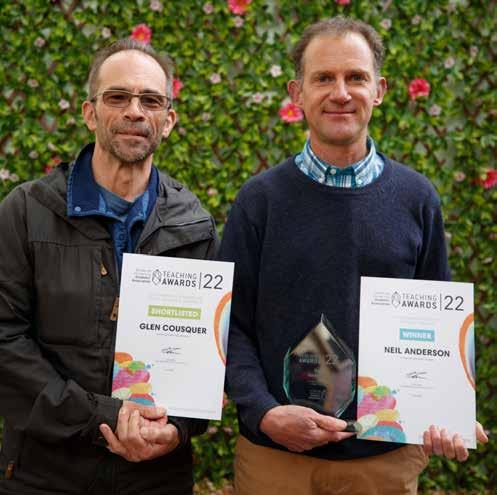
Dr Cousquer encourages students to be critical in academic practice and embeds themes of sustainability and social justice in his teaching. He is committed to highlighting learning outside of the curriculum, particularly in the fields of conservation, protection of the environment and mental health.
A separate team at the School was also shortlisted in the teaching category, for their work in converting a practical orthopaedics surgery rotation into an engaging digital course.
In addition to the above winners and shortlisted nominees, a further 24 staff from the School were nominated for a variety of award categories including ‘Best Tutor, ‘Outstanding Course’, ‘Best Support Staff’ and ‘Best Teacher’.
This year, the EUSA awards team received more than 2,680 nominations from students.
“These results are a testament to the exceptional work done by our student teaching and support teams.”
Professor David Argyle Head of the Royal (Dick) School of Veterinary Studies
Clinical
Gut bacteria transplants to ease chronic illness
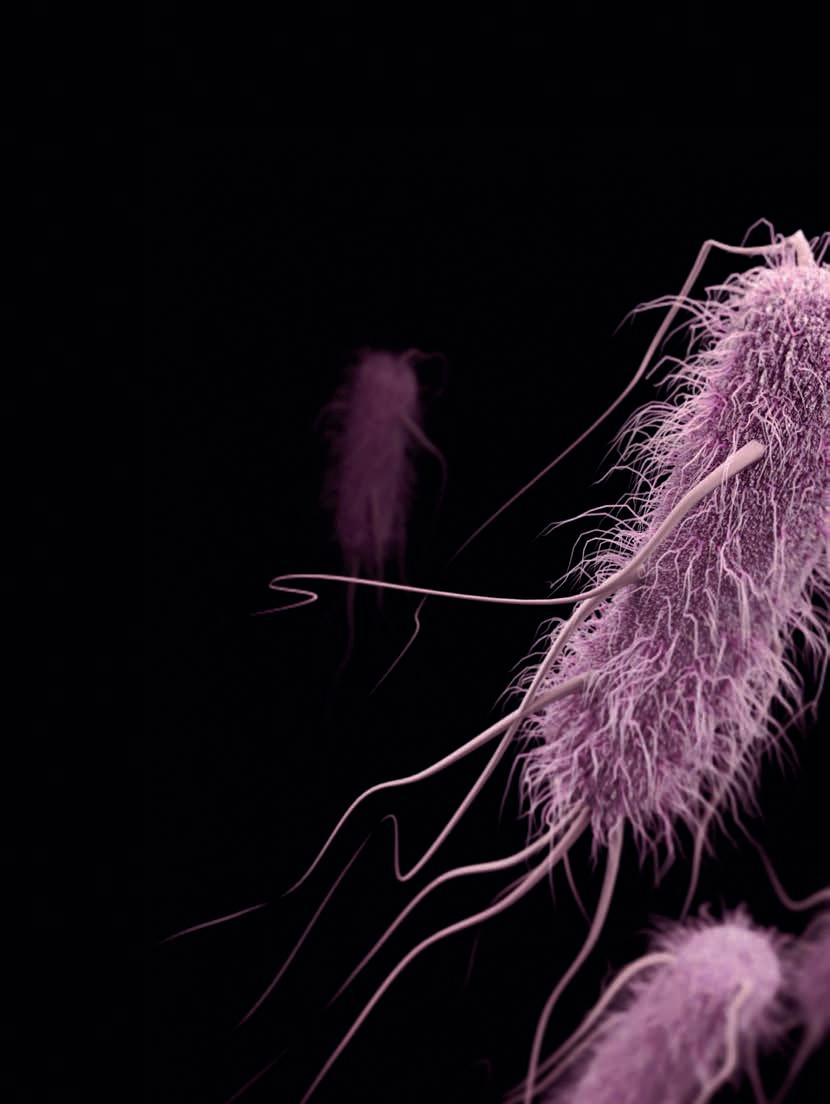
Researchers at the Dick Vet are investigating the potential of managing chronic gut conditions by transplanting beneficial gut bacteria in faeces from healthy dogs into affected dogs.
Experts in veterinary internal medicine are studying the technique as a treatment that could be tailored to alleviate long-term illness, and reduce reliance on conventional treatment with antibiotics and immune suppressants.
The potential treatment may help dogs affected by chronic inflammatory enteropathy, which is similar to inflammatory bowel disease in humans.
We are also researching the impact of different types of fibre in canine diets, which
could be used to generate beneficial bacteria in the guts of healthy dogs, for donation to sick dogs.
Early results suggest treatment gives temporary improvement, and full results could establish whether the composition of bacteria in the guts of donor dogs could be managed to create bespoke transplants for dogs with gastrointestinal conditions.
Our experts hope the results of their research, supported by the Fiona and Ian Russell Seed Corn Fund, will enable a step toward the development of faecal transplants as a standard treatment for gastrointestinal conditions.
Consensus sought on dog gut bacteria transplants
Standard practices are needed to optimise the impact of donating healthy gut bacteria between dogs, a Dick Vet survey of small animal vet specialists has shown.
A range of methods are in use for the novel therapy, in which bacteria in faeces is transplanted to alleviate chronic gut conditions, according to the international study. The findings highlight the need for consensus on how best to employ the practice of faecal microbiota transplants (FMT), so that it can be used to best advantage.
Outcomes from the survey will be used by vets in the Companion Animal Faecal Bank Consortium to establish a protocol for preparation, dosing and administration of FMT in dogs.
Efforts by the consortium to reach a
consensus for vet practitioners and specialists around the world will focus in the first instance on the administration of FMT, followed by protocols for screening of donor dogs and the best practices for treating severe or long-term diseases. Vets will also aim to clarify which details need to be addressed most urgently for research towards using FMT in chronic or acute cases in both dogs and cats.
In the longer term, the consortium’s work may include determining whether some dogs may make suitable superdonors, whose gut bacteria is effective in alleviating a range of illnesses.
Questionnaire helps diagnose dog behavioural problems
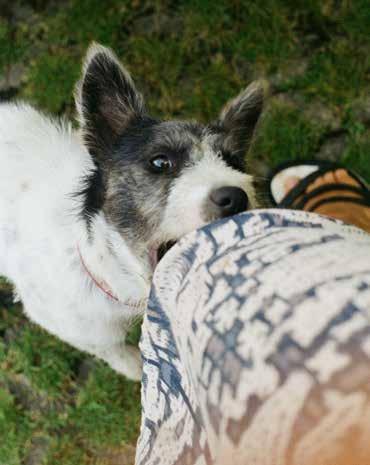
Behavioural problems in dogs can be assessed with help from an owner-completed questionnaire, according to a study led by the Head of the Behaviour Clinic at the Royal (Dick) School of Veterinary Studies, alongside colleagues from the Universities of Lincoln and Leeds.
Tests involving dogs and their owners have helped validate the Canine Frustration Questionnaire, which aims to meet the need for an accurate tool to identify frustration in dogs.
The questionnaire is designed to be completed by a dog owner and scored by a behaviourist, who assesses the role of frustration in the dog’s behaviour problems and informs recommended treatment. It is designed to allow for objective measurement of a dog’s tendency to become frustrated, the assessment of which has previously relied on subjective evaluation by clinicians.
In this new study, more than 40 dogs underwent a single series of short behaviour tests replicating real life scenarios which can induce mild frustration – such as being left alone, being ignored or being denied food or toys. After each short test, dogs were permitted access to the food, toys or attention which they had previously been denied.
Dogs were filmed throughout the tests, and levels of a stress hormone, cortisol, in samples of their saliva were recorded before and after the tests. Behaviours including vocalising and lunging, plus changes in cortisol, were associated with frustration scores from the questionnaire.
Researchers say the approach will help recognise the important role of frustration in dog behaviour problems that might previously have been attributed to fear or anxiety. Pilot studies have also suggested the questionnaire may be useful in veterinary research to assess the effectiveness of treatments for frustration-related problems in dogs.
Internal Medicine service designs innovative fluoroscopy solution
An innovative device designed by a group of our vets at the Hospital for Small Animals has improved the practicalities and safety issues associated with conducting fluoroscopy procedures.
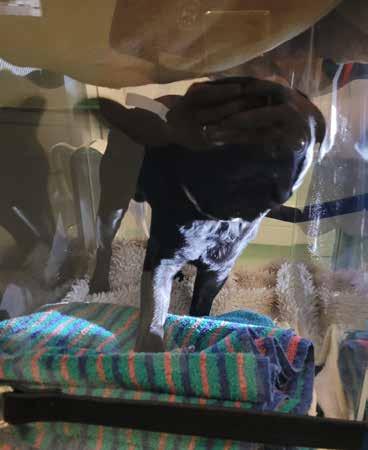
Fluoroscopy is a non-invasive imaging technique that produces continuous images displayed on a monitor, similar to an X-ray movie. Conducting fluoroscopy procedures on animals is difficult, as the patients need to stand still on their own so that staff are not exposed to the electromagnetic waves used in the procedure.
To solve this problem, our specialist Internal Medicine Service team designed a unique acrylic box for animals to stand in during swallow studies. As the box has no metal components, it gives clear images, and allows the animal to stand and eat comfortably.
Our Internal Medicine Service demonstrated the multiple benefits of their innovative fluoroscopy container recently when Gary, a three-yearold pug, was referred to our hospital suffering from severe abdominal cramping. The team was concerned that Gary might have gastric acid reflux or a hiatal hernia, so conducted some swallow studies using the Hospital’s fluoroscope.
Gary remained calm and relaxed in the fluoroscopy container throughout the procedure and the vets were able to diagnose some acid reflux, but nothing else untoward. Gary is now receiving treatment for his reflux and is doing well.
Dysfunction of the food pipe; acid reflux; obstructive airway syndrome; and eye, skin and spinal problems are more common in brachycephalic dogs like Gary because of their body shape and structure. Potential buyers of brachycephalic puppies should be aware of these health issues before purchasing these breeds.
‘Storytelling with Dogs’ explores what it means to feel at home
‘Storytelling with Dogs’ was part of an interdisciplinary project exploring what it means to be ‘at home’ and ‘homeless’ in the city. Outcomes from the project will inform the work of All4Paws, a Dick Vetled and student-powered service offering clinical veterinary care to the animals of homeless and vulnerably housed people in Edinburgh.
The event brought 20 people together to share animal-themed stories, poetry and anecdotes. Writer and art critic Tom Jeffreys led a discussion on a variety of fiction, non-fiction, myths, and poetry featuring dogs. Those attending shared their favourite short stories and poems, including pieces they had written themselves.
All4Paws has secured new premises in Newington, with plans to formally launch this community space in 2023. You can learn more about the services at www.all4pawsedinburgh.org.
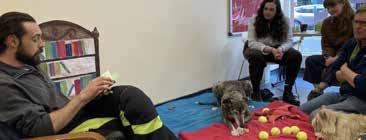
Dog benefits from innovative dentistry procedure
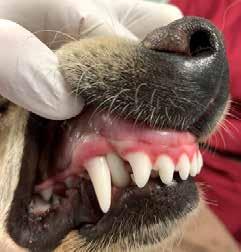
Adog whose misaligned canine tooth was causing severe pain has successfully had her tooth realigned at the Hospital for Small Animals, after being fitted with an orthodontic bite plane.
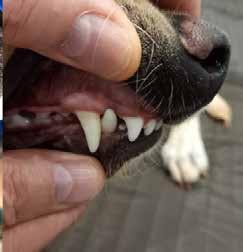
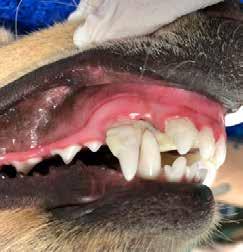
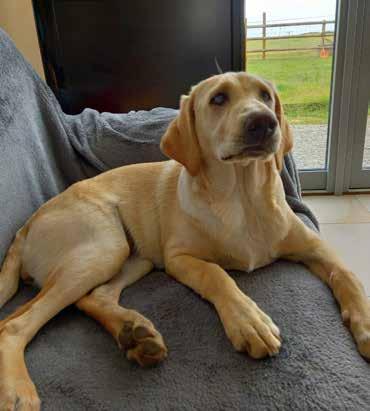
Minnie, a six-month-old Labrador Retriever, was born with a genetic condition known as lingually displaced mandibular canine teeth. This caused one of her bottom canine teeth to grow in the wrong direction. As a result, the tooth dug into and damaged her upper gum, causing her a lot of pain.
Lingually displaced mandibular canines often result in a dog’s bottom baby and/or adult canine teeth erupting in an incorrect position. Minnie was also born with a mild mandibular distoclusion, which means that her lower mandible, or jaw, is shorter than normal.
Collectively, these conditions resulted in one of Minnie’s lower adult canine teeth to tip forward and damage the soft tissue of the gum between her upper canine tooth and third incisor.
Canine teeth provide important structure to a dog’s mouth. Keen to avoid invasive procedures to shorten or remove the troublesome bottom canine tooth, ours vets fitted an orthodontic device called an inclined bite plane to Minnie’s upper jaws. The device was left in place for six weeks, during which the lingually displaced adult canine tooth was successfully tipped back into a normal position.
Minnie’s condition is developmental and hereditary. Dogs with lingually displaced mandibular canine teeth, or their parents and siblings, should be discouraged from breeding to ensure that the problem does not pass to future generations.
Pet fitted with glucose monitor now in diabetic remission
A Dog blood donors deliver milestone achievement
Over the past seven years, more than 600 dogs have together donated 514 units of blood at the Dick Vet, which provided enough blood products to help save the lives of up to 2,056 other dogs.
Like humans, there are times when dogs need blood transfusions. Pet Blood Bank run donation sessions at veterinary practices across the UK, where blood from donor dogs is separated into different products and stored, making it available to vets when needed, with every unit of blood able to help up to four other dogs.
A veterinary team from the Hospital work with Pet Blood Bank staff and run blood donation sessions at the Hospital every eight weeks. Owners of dogs on the Pet Blood Bank register in the Edinburgh area are contacted and asked to bring their dogs in to donate, depending on what blood type is most needed at the time.
After a health check by a vet, the dogs donate blood in a painless procedure that takes less than 10 minutes, before being rewarded with treats and Pet Blood Bank goodies.

As a busy emergency veterinary hospital, the Hospital for Small Animals performs several canine blood transfusions a week. Being able to access blood easily through the Pet Blood Bank benefits both vets and patients.
pet cat is now in diabetic remission after her glucose levels were successfully monitored by our Hospital for Small Animals.
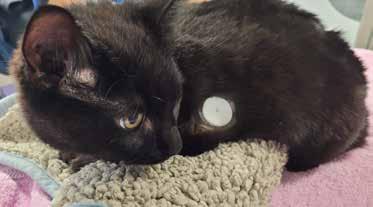
Shadow, a 10-year-old cat, was recently referred to our Hospital by her vet. She presented as an emergency case and was in considerable distress, with free fluid in her chest and abdomen. Our Hospital’s Emergency and Critical Care team quickly stabilised her and diagnosed severe pancreatitis and vasculitis. Sadly, due to her pancreatitis, she also developed diabetes.
As well as treating her pancreatitis and vasculitis, Shadow’s diabetes needed to be closely monitored by our Internal Medicine Team. After consulting with her owners and primary vets, she was fitted with a permanent glucose-monitoring device. This allowed Shadow’s owners to take her home and measure her glucose levels on their phone through a Bluetooth reader. The information about her blood glucose levels was then passed back to the Internal Medicine team, who adjusted her insulin as required.
Three months after being referred to the Hospital, Shadow’s pancreatitis has now subsided and she is in diabetic remission, with no more insulin requirements. Her free fluid is gone and she is no longer on diabetic diet. Shadow continues to recover at home and her glucose monitor has been removed. She does not need further rechecks with our Internal Medicine Service but will have regular assessments at her home vets.
Novel surgical procedure saves snow leopard’s eye
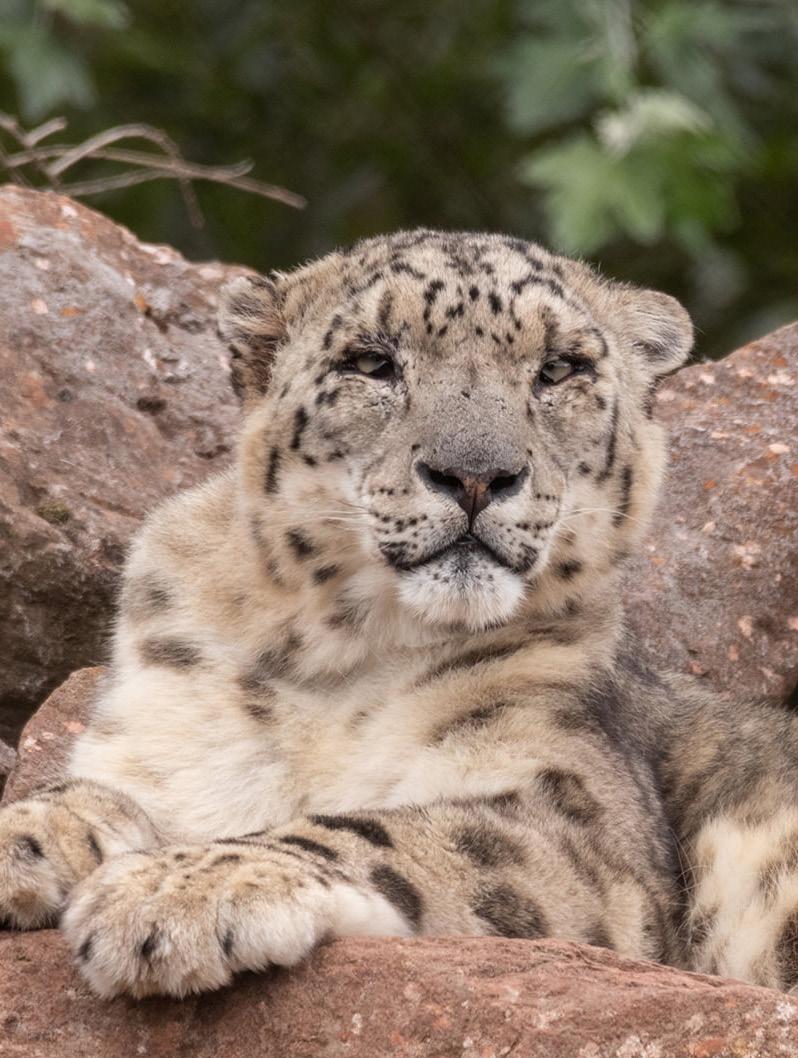
Ateam of our vets treated a snow leopard at Cumbria Zoo Company, after he failed to respond to early interventions for an eye condition.
Keepers at the Cumbria Zoo Company noticed that one of their snow leopard’s eyes had become red and inflamed. Their veterinary team examined Wolfgang, or Wolfie as he is affectionately known, under anaesthetic, and found that had a large ulcer in the centre of his eye that was close to rupturing. Also, the soft tissues of his eyelid and part of his conjunctiva – the clear membrane on the upper and lower eyelids – were inflamed and swollen.
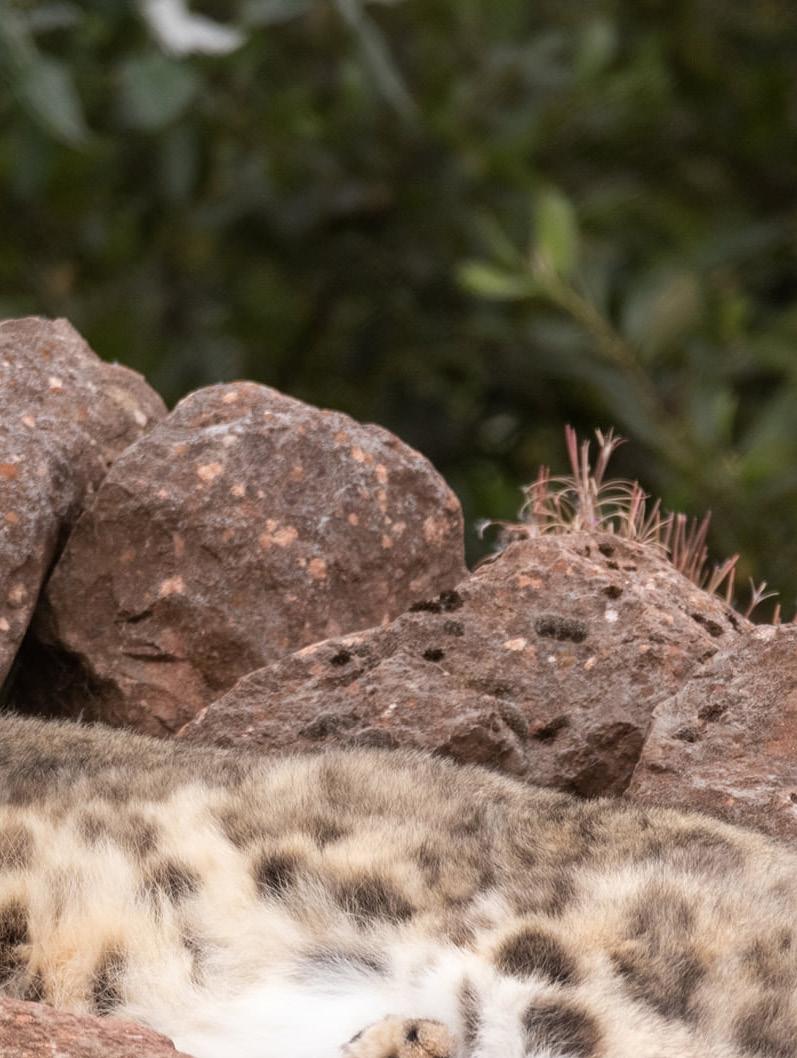
Given the severity of the ulcer, surgery was required. Veterinary surgeons from the International Zoo Veterinary Group performed a procedure to remove the dead tissue and encourage the cornea to heal. However, after a
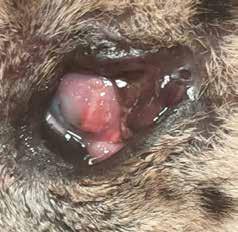
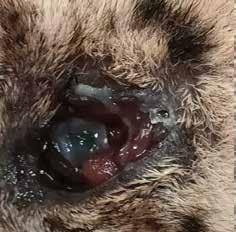
week, Wolfie’s eye wasn’t showing any signs of improvement and he was at significant risk of losing his eye. The team asked our vet Claudia Hartley, one of the world’s leading veterinary ophthalmologists, for help.
Dr Hartley and Kris Houston, an Ophthalmology Resident at the School, examined Wolfie under anaesthetic, before conducting a conjunctival graft – an intricate procedure in which a piece of healthy membrane is taken from the eye, placed over the ulcer, and held in place using dissolvable stitches.
Within days of the operation, Wolfie’s eye was much improved. Under the continued supervision and care of the veterinary team at Cumbria Zoo Company, he is now back to full health.
Dr Hartley said: “Wolfie had a particularly nasty deep corneal ulcer which, if left untreated, would have undoubtedly led to him losing his
sight and his eye. I was delighted to work with the excellent veterinary team at Cumbria Zoo Company and the International Zoo Veterinary Group and am pleased that Wolfie has made a full recovery.”
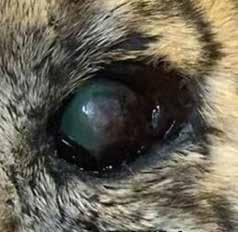
A spokesperson from Cumbria Zoo Company said: “A massive thank you to Claudia and the team for their treatment of Wolfgang’s eye issue. We, and Wolfgang, are so lucky to have been able to draw on Claudia and the team’s expertise, when faced with such an unusual and worrying situation which could have resulted in Wolfie losing his eye should treatment have not been available. We were thrilled to see Wolfie’s eye recovering within days of the second procedure and happy to report he is now back to his lovely self!
Before procedure.
After.
Healing nicely.
Infection and Immunity
Enzyme therapy shows promise for childhood dementia
Studies led by Washington University School of Medicine and the Roslin Institute into Batten Disease, a rare nervous system disorder that causes dementia and early death in children, have highlighted a possible treatment.
Regular infusions of a key enzyme that is deficient in children with infantile Batten disease, also called CLN1 disease, led to improvements in mice and sheep with an equivalent genetic disorder.
The findings could inform development of effective treatments for children with the disease, which can lead to loss of vision, cognitive and movement dysfunction, seizures and early death.
Scientists studied the effect of administering doses of the enzyme, known as PPT1, in mice and sheep with the same faulty gene that gives rise to the disease in children.
Monthly doses of the PPT1 enzyme to the brains of mice led to improved motor function, reduced signs of disease in brain cells, and reduced loss of brain matter over six months of treatment.
The research team first verified the dosage of enzyme and route of administration needed to have a beneficial effect in mice, and extrapolated their findings to determine effective enzyme infusion treatments for the affected sheep.
This critical step demonstrated that treatments which are promising in mice can be scaled up to have a similar positive treatment effect in a much larger brain.
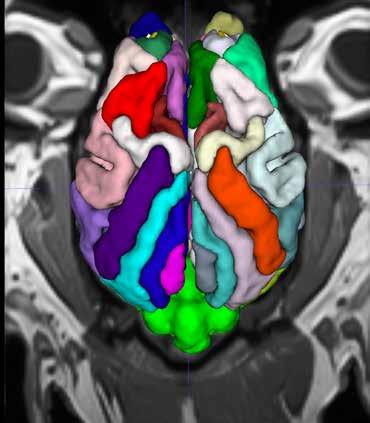
Their study built on a similar approach for a different form of Batten disease, known as CLN2, which has led to a therapy called cerliponase alfa or Brineura. This has been approved by the NHS following successful clinical trials in a collaboration between centres around the world.
The latest study using mice and sheep has enabled insights into the effect of the therapy by testing basic principles in mice then refining them in a mammal whose brain size and complexity is comparable to that of children. The research team hope to conduct further studies to refine effective timings and dosage of enzyme replacement therapy, to move towards an effective treatment for this devastating childhood disorder.
Batten disease, one of several conditions known as lysosomal storage disorders, is an umbrella term for a group of neurodegenerative conditions caused by genetic mutations that affect cells’ waste disposal and recycling system.
These conditions can present at varying stages of childhood, depending on which gene is deficient. The PPT1-deficient CLN1 form of the disease develops in early childhood, progresses rapidly and there is currently no therapy available.
The Roslin team developed a sheep model for this disorder using the genome editing technology CRISPR/Cas9, so that therapeutic studies such as this could be done.
This enabled researchers to better understand the mechanisms underpinning progression of the disease, and to assess novel methods of managing the condition. The animals show many hallmarks of the disease in children, from signs of disease in cells through to changes in the size of the brain.
The study was published in the Journal of Clinical Investigation. This work was funded by the US National Institutes of Health, including an SBIR grant to Collaborations Pharmaceuticals, and the Haley’s Heroes Foundation.
This study could only have been done by a collaborative research team. Such work is a key step towards everyone’s ultimate goal of safely carrying out clinical tests of potential treatments in children affected by this devastating condition. Through studies in sheep, we gain invaluable insights into the progression of this condition which can guide our work towards developing an effective therapy.
Gene editing plus vaccines could eradicate disease
PRRS could be eliminated in less than three years with optimal distribution and effective vaccines, research led by the Roslin Institute suggests.
Some livestock diseases could potentially be eradicated by introducing a proportion of animals that are genetically resistant to disease due to gene editing into some vaccinated herds. Gene-edited pigs resistant to disease would be introduced into breeding programmes and over generations, pigs would become genetically resistant to disease.
Eliminating disease on a national scale would be difficult to achieve using gene editing or vaccination alone, but it would be possible by combining the two approaches, computational models predict. Having 10 per cent of genetically resistant animals in a fraction of herds may eradicate disease in three to six years.
Findings from the study, which focused on Porcine Reproductive and Respiratory Syndrome (PRRS), could help eradicate this deadly disease, which costs the pig industry more than £1.75 billion per year in the US and Europe alone.
Gene-edited pigs that are resistant to PRRS have been produced at the Roslin Institute and are the subject of ongoing collaborative research.
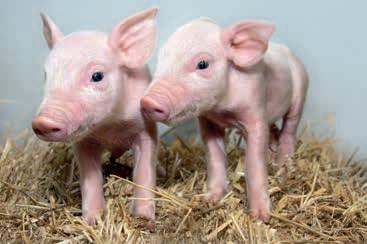
The study was a collaboration between the Roslin Institute and agribusiness consultants AbacusBio.
Genetic analysis key to understanding Legionella risk
Routine sampling of water supplies and genomic sequencing of Legionella bacteria – determining its entire genetic makeup - could play a key role in identifying the source of Legionnaires’ disease outbreaks, research led by the Roslin Institute suggests.
The measures could also inform public health efforts to limit the spread of infection, according to a genomic study of the Legionella bacteria that causes the disease. Improved testing is crucial, researchers say, because the disease – a severe form of pneumonia – is contracted by inhaling the bacteria in aerosols – tiny droplets - of contaminated water.
Outbreaks are often linked to water systems in hotels, cruise ships and hospitals, and also within the community.

Diseases in spotlight at One Health workshop
The challenge presented by emerging zoonotic diseases, and how best to model and control them, was the focus of an online workshop held in February and involving researchers from Scotland and China.
The event, involving the Global Academy of Agriculture and Food Security, the University of Edinburgh’s Global Health Academy and Shanghai Jiao Tong University, was supported by the British Council and National Natural Science Foundation of China, and titled ‘One health: surveillance and early warning for zoonoses’.
Talks spanned contributions of One Health approaches to sustainable development, advances in surveillance and response to zoonoses. Participants also considered the challenges of both emerging and endemic zoonoses, opportunities afforded by developments in technologies such as genomics, and modelling for pandemic preparedness.
A team from the Roslin Institute and the University of Glasgow, Public Health Scotland and the Scottish Legionella Reference Laboratory compared the genomes, or genetic codes, of more than 3,000 Legionella bacteria samples found in patients and in water sources from Scotland and around the world.
The results revealed a new level of detail and fresh insights into the characteristics of Legionella bacteria and its transmission in Scotland.
From analysis of the genetic code, researchers found that Legionella infections linked to people travelling were often closely related to other variants from the same UK or international destination.
The analysis found that nearly one-third of infections in Scotland acquired in the community - not hospital or travel associated - were caused by a single variant. The team say this variant should be closely monitored.
Distinct variants of the bacteria were found in some hospitals over a long period of time – up to 17 years in some instances - which suggests that the bacteria persisted or were repeatedly introduced into hospital water systems.
The team also found that there had been no reported cases of Legionnaires’ disease in any Scottish hospital in the past 10 years. This is likely due to effectiveness of new control measures introduced during this time, experts say.
This work has been funded by the Chief Scientist Office, UKRI and Wellcome.
Genetic finding could help beat fatal cattle infection
Akey region of DNA has been identified that enables some cattle to survive a potentially devastating infection, raising the prospect of breeding livestock that do not succumb to the disease.
Researchers from the Centre for Tropical Livestock Genetics and Health (CTLGH), Roslin Institute, the International Livestock Research Institute (ILRI) and the University of Glasgow sought to understand whether regions of the cattle genome passed on between generations might equip some animals to survive infection with East Coast fever.
Genetic analysis of Boran cattle – an East African breed in which some animals can tolerate the disease – enabled the team to identify a region of DNA that may have a key role in preventing deadly infection. The results suggest a gene in the region may help to prevent the uncontrolled production of infected cells and reduce the risk of an animal becoming seriously ill or dying.
The outcome suggests that breeding cattle which carry the key genetic region, or developing cattle whose DNA is edited to carry the necessary genetic signature, may increase the tolerance to East Coast fever in imported cattle across Africa.
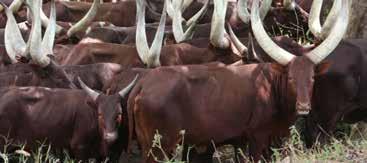
The discovery could help efforts to target East Coast fever, or theileriosis, which kills one million animals each year and costs farmers US$600m, largely affecting smallholders in sub-Saharan Africa. It could allow farmers in affected regions of Africa to keep non-native breeds with higher productivity, so long as they carry the necessary genomic signature to tolerate the disease.
The study, published in PLOS Genetics, was funded by the Bill & Melinda Gates Foundation and UK Foreign, Commonwealth and Development Office (FCDO) and supported by CGIAR and the Biotechnology and Biological Sciences Research Council, part of UK Research and Innovation.
Stem cell approach to aid study of pig infections
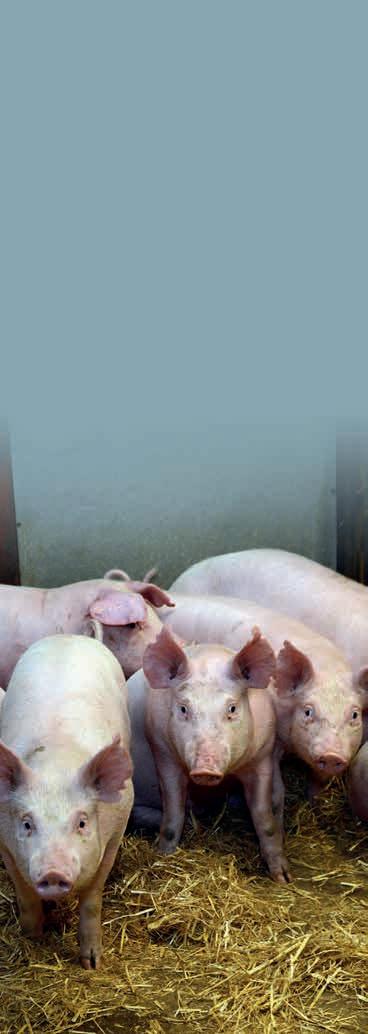
Astudy led by scientists from the Roslin Institute suggests that a new method of producing immune cells from stem cells for research into pig infections is more affordable, practical and ethical than standard approaches.
Our scientists produced a type of immune cell - called macrophages - from pig stem cells, through a protocol adapted from a method used for mouse and human cells. They observed they had similar features to macrophages used in existing procedures, and served as targets for infection by key pig infections, such as Salmonella and the viruses that cause African swine fever and porcine reproductive and respiratory syndrome.
Investigations using the technique will benefit from access to an unlimited number of macrophages, which are easy to manipulate and can be infected by viruses and bacteria for a range of studies. The method reduces the need for animals in research and is less costly than conventional procedures, which use macrophages extracted from slaughtered animals and require continuous replacement.
Work conducted using the approach will be critical for devising effective strategies to combat important diseases such as African swine fever, and improve healthy, ethical livestock farming. For instance, the technique could be used to produce virus for the development of live vaccines.
Stem cell-derived macrophages can also be gene edited for targeted studies of the role of genetics in infections, for biotechnology applications, and to generate bespoke engineered cells for experiments.
Dr James Prendergast, Roslin Institute and Centre for Tropical Livestock Genetics and HealthThe discovery of genes that enable cattle to survive infection with East Coast fever offers a route to introduce this beneficial DNA to non-native breeds, enabling reduced disease incidence and increased productivity, which would be of benefit to millions of rural smallholder farmers in Africa.
Antibiotic resistance predates modern medicine
Bacteria that are resistant to antibiotics commonly infected hedgehogs some 200 years ago, long before they became a widespread problem for modern medicine, research involving scientists from the Roslin Institute has shown.
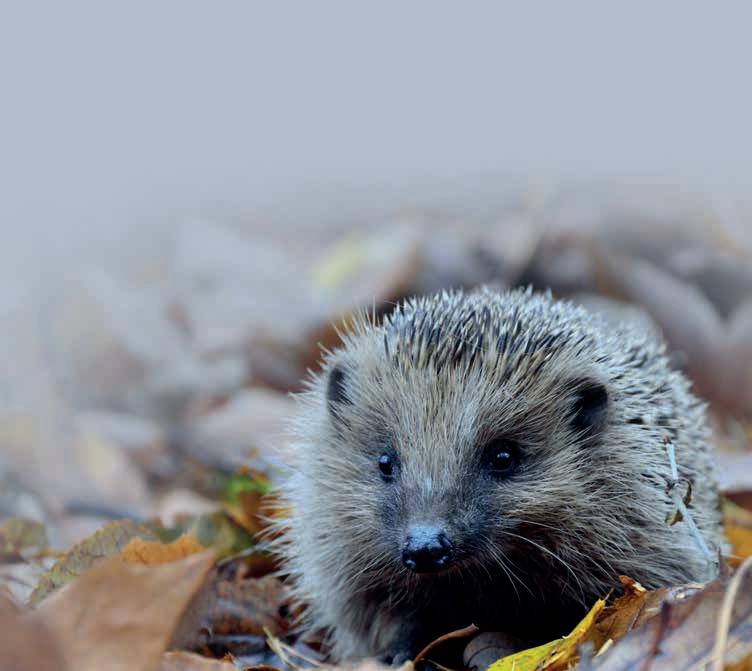
The bacteria methicillin-resistant Staphylococcus aureus – MRSA – infected hedgehogs in the 1800s, spilling into other species including humans, well before the clinical use of antibiotics, the DNA study of bacterial evolution has demonstrated.
A common fungus living on the skin of hedgehogs promoted the emergence and spread of these bacteria, the findings suggest. Antibiotic substances produced by the fungus created conditions that favour the resistant bacteria’s survival.
The discovery in animals of an antibiotic resistant bacteria that infects humans underscores the importance of collectively considering the health of people, animals and the environment, scientists say.
This One Health approach could help to better understand and manage antimicrobial resistance, which is considered by the World Health Organization as an important threat to human health.
The international study was led by Statens Serum Institut, Copenhagen, Denmark and the University of Cambridge, and involved the Roslin Institute and partners across Europe and the US.
Plaudits for antibiotic resistance tracking system
Asurveillance approach for antimicrobial resistance among people and their livestock, co-developed and piloted by Roslin Institute scientists, has been hailed as a success story.
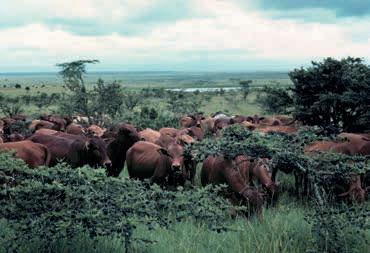
Experts from government, hospitals and universities, led by the Roslin Institute, took part in establishing a pilot research project in Uganda, where the team of specialists in diagnostics, antibacterial stewardship and disease surveillance worked together to create a blueprint for a One Health antimicrobial resistance (AMR) surveillance programme.
They sought to better understand the impact of antibiotic use in hospital and community settings on the incidence of antimicrobial resistance, studying cases of infection and resistance to treatment in hospital patients, and traced whether animals kept by the patient were affected. They also inspected animals in communities for disease and resistance, and checked for corresponding incidences in their owners.
The multi-disciplinary method is designed to highlight links between infections, and resistance to antibiotic treatment, in people and animals in communities in low- and middle-income countries, which are disproportionally affected by AMR. The approach could give valuable insight into how infection spreads between people and livestock in a community environment, and the timescales involved.
The team’s efforts have been recognised following their presentation to the Call to Action in AMR virtual conference, organised by the International Centre for AMR Solutions (ICARS). The scheme, supported by the Fleming Fund Fellowship, is being expanded to One Health scientists from Uganda and Malawi and policy professionals from Kenya, to continue the work into next year.
Infection and Immunity Gene variants linked to severe cases of Covid-19
Fresh details of some biological mechanisms behind severe Covid-19 have been revealed in the world’s largest study of the genetics of the disease, involving more than 57,000 people.
Some 16 new variations of genes associated with severe Covid-19, including some related to blood clotting, immune response and intensity of inflammation, have been identified in the study, led by scientists at the Roslin Institute.
Researchers from the GenOMICC (Genetics of Susceptibility and Mortality in Critical Care) consortium – a global collaboration to study genetics in critical illness – led by the University of Edinburgh in partnership with Genomics England, made these discoveries by determining the genetic codes of 7,491 patients from 224 intensive care units in the UK.
The patients’ DNA was compared with that of 48,400 other people who had not had Covid-19, who are participants in Genomics England’s 100,000 Genomes Project, and that of a further 1,630 people who had experienced mild Covid-19.
Determining the whole genome sequence for all participants in the study allowed the team to create a precise map and identify genetic variation linked to severity of Covid-19. The team found key differences in 16 genes in the ICU patients when compared with the DNA of the other groups.
They also confirmed the involvement of seven other genetic variations already associated with severe Covid-19, discovered in earlier studies from the same team.
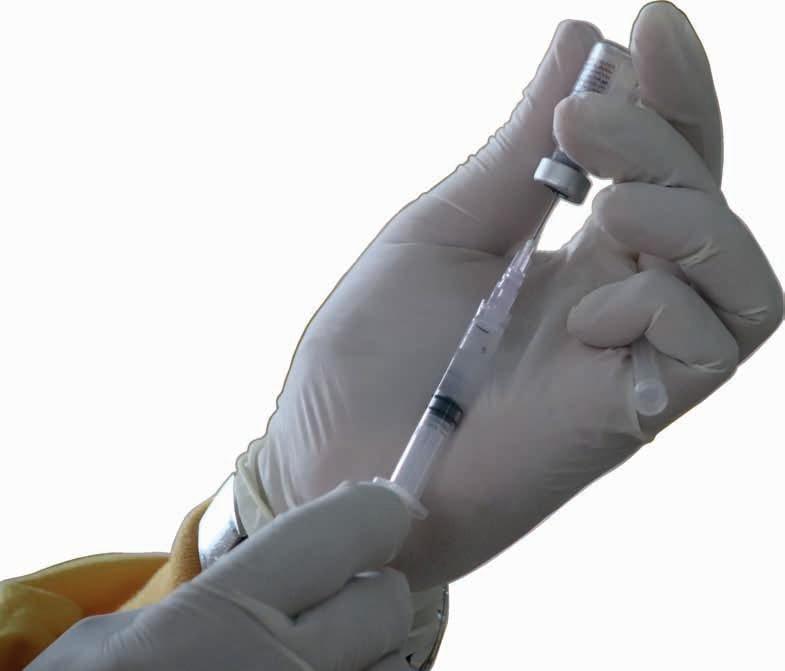
“Our latest findings point to specific molecular targets in critical Covid-19. These results explain why some people develop life-threatening Covid-19, while others get no symptoms at all. But more importantly, this gives us a deep understanding of the process of disease and is a big step forward in finding more effective treatments.”
- Professor Kenneth Baillie, Personal Chair of Experimental Medicine.
The findings included how a single gene
variant that disrupts a key messenger molecule in immune system signalling – called interferon alpha-10 – was enough to increase a patient’s risk of severe disease.
This highlights the gene’s key role in the immune system and suggests that treating patients with interferon – proteins released by immune cells to defend against viruses – may help manage disease in the early stages.
Variations in genes that control the levels of a central component of blood clotting – known as Factor 8 – are associated with critical illness in Covid-19, the study, published in Nature, found.
This may explain some of the clotting abnormalities that are seen in severe cases of Covid-19. Factor 8 is the gene underlying the most common type of haemophilia.
“It is now true to say that we understand the mechanisms of Covid better than the other syndromes we treat in intensive care in normal times – sepsis, flu, and other forms of critical illness.
Covid-19 is showing us the way to tackle those problems in the future.”
- Professor Kenneth Baillie, Personal Chair of Experimental Medicine.
GenOMICC is funded by the UK Department of Health and Social Care, LifeArc, the charity Sepsis Research FEAT, the Intensive Care Society, Wellcome, UK Research and Innovation, Scotland’s Chief Scientist Office, the Department of Health and Social Care and the National Institute for Health Research (NIHR), and supported by Illumina.
Cell marker methods aid study of poultry immunity
Novel approaches to identifying key molecules associated with immunity have enabled a team of researchers led by the Roslin Institute to identify a chicken immune cell with a critical role in mediating fighting infection. The findings, from the first study of its kind in birds, highlight key similarities and differences between mammalian and avian immunity.
The researchers developed methods of distinguishing signature molecules associated with the function of key immune cells known as conventional dendritic cells. Their work will underpin studies of conventional dendritic cells, which play a key role in fighting infection in many species, but are difficult to detect in birds.
In a novel approach, the team developed reagents designed to react with molecules involved in conventional dendritic cell development and function. They generated an antibody that could be used to detect a key molecule named FLT3 and fluorescently labelled a peptide, a small protein, which could detect a second molecule, XCR1, on the surface of conventional dendritic cells.
By using these markers, researchers were able to distinguish dendritic cells from other cell types, and to discover insights into their function, including details of how they interact with Salmonella bacteria.
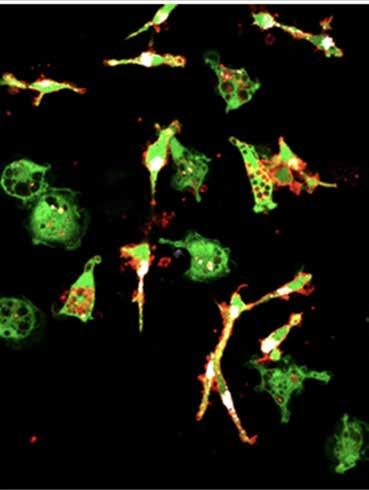
The reagents developed for the study will support further research to understand the functions of chicken immune cells, and support development of vaccines against viral and bacterial diseases.
The study, carried out with the University of Queensland, Australia and the National Avian Research Facility at the Roslin Institute, was supported by Wellcome and BBSRC and published in Immunology.
UK scientists join forces to tackle bird flu
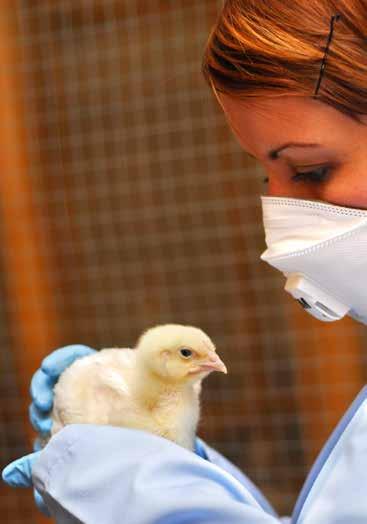
Ateam of experts including scientists from the Roslin Institute is undertaking a £1.5 million project to develop strategies to battle bird flu. The initiative follows a record number of cases in the UK, in the largest and longest outbreak experienced in the country and in many parts of Europe.
The collaboration aims to understand how current influenza virus strains are able to form larger and longer outbreaks, how the virus can penetrate poultry premises, and how these challenges can be addressed.
Scientists will also investigate spread and infection in different bird populations, including how the virus transmits from wild birds to farmed poultry, and why some birds, such as ducks, are more resistant to bird flu strains than others.
They will map and model the spread of infection over time and across species, and will develop models to predict how the viruses will evolve and spread in the future.
Findings from the consortium will inform measures to reduce the risk of disease in birds, thereby preventing spread to humans. Outcomes could also aid the UK’s poultry sector and rural economy, which have experienced significant disruption from this year’s outbreak.
The knowledge gathered will also be shared with international partners to aid their efforts to tackle the disease, with benefits for reduced global risk.
The consortium will be led by the Animal Plant Health Agency (APHA) and funded by the Biotechnology and Biosciences Research Council (BBSRC) and the Department for Environment, Food and Rural Affairs (Defra).
Animal disease centre wins share of £35m funding
The Scottish Government Centre for Animal Disease Outbreaks, EPIC, was awarded a share of more than £35 million secured for four Scottish centres delivering scientific support, research and advice on key issues affecting the climate, water, animal disease outbreaks and rural communities.
EPIC is a consortium of six Scottish research institutions, including scientists from the Global Academy and the Roslin Institute working to improve livestock health by advising the Scottish Government on the surveillance and control of animal diseases.
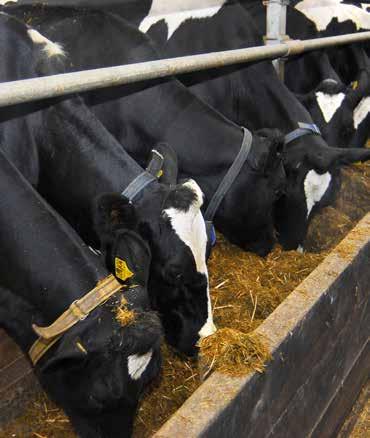
EPIC researchers are currently advising on the ongoing avian influenza outbreaks in the UK and working to address the threat to Scotland of African Swine Fever as this disease spreads into Western Europe.
A five-year investment package will benefit EPIC as well as climate research centre ClimateXChange (CXC), the Centre of Expertise for waters (CREW), and SEFARI Gateway, which leads on knowledge exchange and innovation.
The investment, announced by First Minister Nicola Sturgeon, is aimed at strengthening existing partnerships, helping to safeguard against a range of issues that affect the rural economy, environment and the communities that depend on it.
Racehorse study to shed light on respiratory immunity

Researchers are to investigate why racehorses are susceptible to respiratory illnesses during intense training.
A team from the Dick Vet and the Roslin Institute will use a combination of analysis techniques to study immune cells from horses’ airways and lungs. The findings could inform ways to help alleviate inflammation in the airways, which commonly affect the animals, impacting on their performance.
The study, funded by the Hong Kong Jockey Club Equine Welfare Research Foundation, will seek to identify biological indicators of disease and to better understand processes in the immune system that lead to illness. It aims to build on previous research funded by the Horserace Betting Levy Board, highlighting a link between exercise and changes in immunity, with the latest work focusing on immune cells that originate in horses’ airways.
Scientists hope to aid understanding of conditions affecting the airways including inflammation, known as mild to moderate equine asthma (MMEA), which can significantly impair athletic performance, especially during the early training period. Their work is also hoped to shed light on bleeding into the airways, known as Exercise-Induced Pulmonary Haemorrhage (EIPH), which is also prevalent among training horses. The team will seek to establish whether there is a link between the two conditions.
Researchers will use advanced analytical methods to pinpoint the effects of training on activity in immune cells, and the proteins produced by these cells, to search for biological indicators of susceptibility to disease and possible targets for treatments.
High intensity training has also been linked to respiratory symptoms in humans, with intense periods of exercise being linked to a loss of immune function, and outcomes from the study could also have significance for advancing understanding this phenomenon in human athletes.
The Scottish Government provides significant funding to our major research institutes to explore issues such as plant and animal health, and food security.
Nicola Sturgeon, First Minister of Scotland
Partnership aims to tackle antimicrobial resistance
Afellowship scheme is fostering collaboration to address the global challenge of antimicrobial resistance (AMR), which is predicted to cause 10 million deaths per year by 2050 unless urgently tackled.
One Health professionals, including doctors, vets, pharmacists and microbiologists from Malawi, Uganda and Kenya visited the Roslin Institute in March, where they presented their work, took part in collaborative projects, and learned about Roslin’s AMR research and infrastructure.
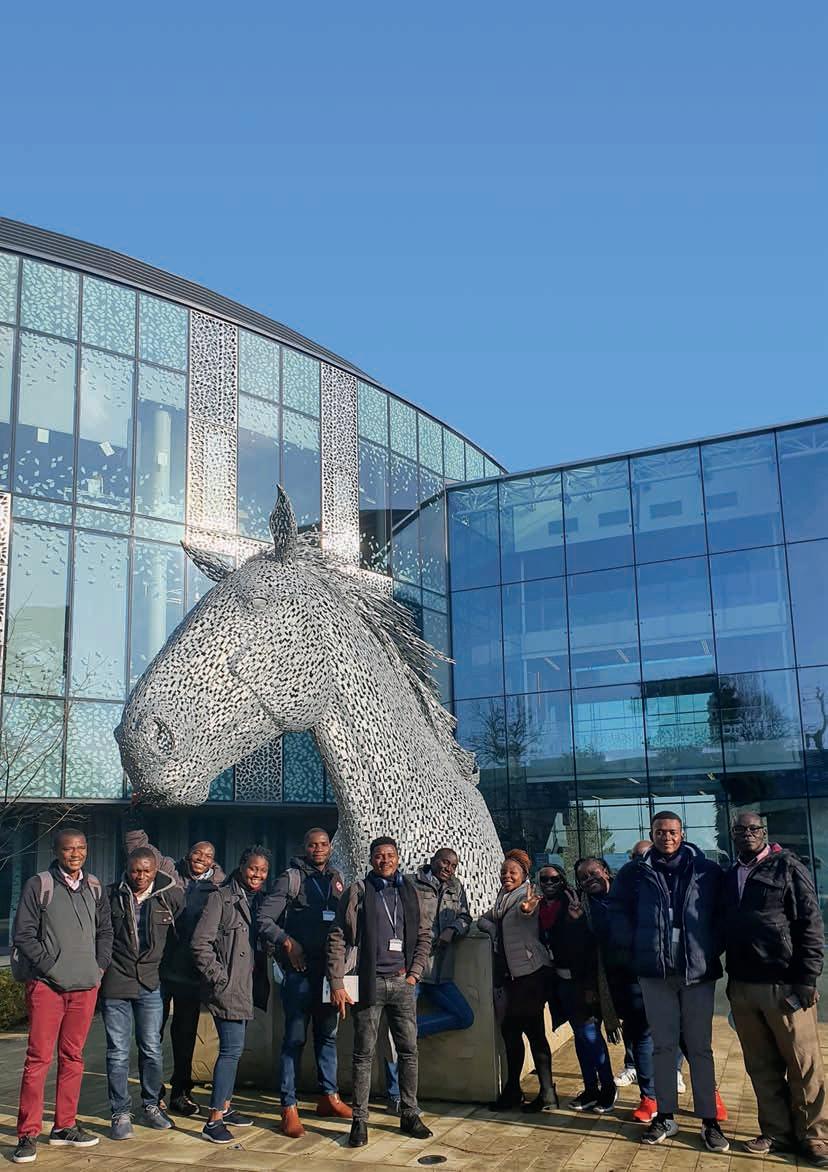
The group are all Fellows of the Fleming Fund, which aims to support low- and middle-income countries
(LMICs) in the fight against AMR. They are supported by the University of Edinburgh as a host institution for the capacity building component of the fellowship scheme.
Their visit, which also included a tour of research facilities, was an opportunity for the fellows to receive technical training from expert mentors from across the University in a range of scientific topics, such as bioinformatics, microbiology, and communication.
The Fleming Fellowship Scheme, which is administered by the Department of Health and Social Care, aims to train practitioners in collection and analysis of high quality AMR surveillance data, and generate information that can be used to guide policy development and implementation.
Fellows will form a global network of AMR experts and advocate for action in their home countries, such as improved AMR surveillance and responsible use of antibiotics.
Milk test could spot common dairy cattle disease
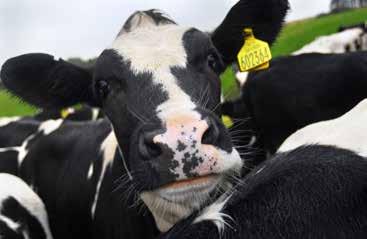
Anovel test for a component in milk could help lower the incidence of a prevalent disease in dairy cattle, research suggests. The discovery, by a team of Roslin scientists, could help to reduce the economic and welfare impact of mastitis, characterised by mammary inflammation, and reduce the use of preventative antibiotics.
Researchers have determined that levels of a molecule found in milk cells could be used as an accurate way to detect inflammation before clinical signs of mastitis are visible, potentially enabling rapid intervention to limit the impact of disease.
A team of researchers sought to examine whether levels of genetic material found in cells, known as miRNAs, could be used as reliable indicators of disease.
They studied levels of four types of miRNAs, previously linked to inflammation, in more than 200 samples of milk taken from cows at various stages of their productive life. These results were compared against mastitis scores using the conventional California Mastitis Test.
Their outcome showed that levels of three of the four miRNA molecules, known as miR-142, miR-146a and miR-223, could potentially be used for high accuracy, early diagnosis of mastitis before the onset of clinical signs.
DNA study could help breed virus-resistant poultry
Astudy of different types of chickens – known to be either more resistant or more susceptible to common poultry viruses – has uncovered dozens of variations in genes with a central role in the chicken immune response to infection. The findings, by a team of scientists from the Roslin Institute, may point to genetic variations that determine birds’ response to infection, to help breed poultry that are resistant to disease.
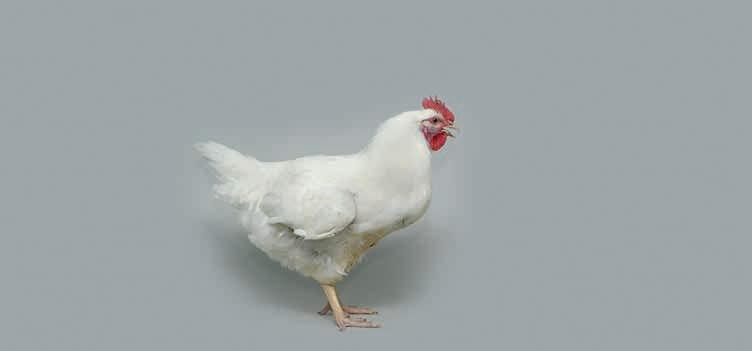
Researchers analysed DNA from chickens that have been found to be naturally more resilient or prone to bird flu, Marek’s disease, infectious bursal disease, or
Covid-19 mixed with flu raises risk of severe illness
Patients with co-infection of SARS-CoV-2, which causes Covid-19, and flu viruses were more than four times more likely to need ventilation support and almost two and half times more likely to die than if they had Covid-19 only, a study involving the Roslin Institute found.
The findings show the need for greater flu testing of Covid-19 patients in hospital and highlight the importance of full vaccination against both Covid-19 and the flu, according to researchers.
The team from the Roslin Institute, University of Edinburgh’s Centre for Inflammation Research and Usher Institute, University of Liverpool, Leiden University and Imperial College London, made the findings in a study of more than 305,000 hospitalised patients with Covid-19.

The research – delivered as part of the International Severe Acute Respiratory and emerging Infection Consortium’s (ISARIC) Coronavirus Clinical Characterisation Consortium – is the largest study to date of people with Covid-19 and other endemic respiratory viruses.
ISARIC’s study was set up in 2013 in readiness for a pandemic such as this. The team looked at the data of adults who had been hospitalised with Covid-19 in the UK between 6 February 2020 and 8 December 2021.
Test results for respiratory viral co-infections were recorded for almost 7,000 patients with Covid-19. Some 227 of these also had flu, and they experienced significantly more severe outcomes.
infectious bronchitis virus, all of which are costly viruses for the poultry industry. Computer analysis looked for variations in the genes linked to production of immune proteins known as interferons, and other associated molecules.
The team sought to compare their findings with a standard reference genome for chickens, to determine the effect caused by variations in these regions of DNA and how they might be associated with each bird’s response to infection. In all, their analysis highlighted 60 genetic variations that are likely to influence resistance or susceptibility to one of the four infections.
Further research could involve testing the impact of these DNA variations on chicken cells and exposing these to each of the four viruses in the lab, to better understand the mechanisms involved. This could help determine which genetic variations could be bred into chickens to enable the birds to resist viral infection. The discovery could also inform research into drug design or vaccine improvement to protect poultry against infection.
Brain immune cell limits impact of degenerative disease
An immune cell found in the brain has a role in limiting the damage caused during neurodegenerative disorders, a study led by researchers from the Roslin Institute suggests. These cells, known as microglia, protect nerve cells from damage caused by prion disease, which occurs when prion proteins in the brain fold incorrectly.
The study followed previous research indicating that when microglia levels were reduced, disease progressed faster and there was an increased accumulation of prions in the brain. This suggested that microglia had a role in destroying prions in the brain and lessening the impact of disease.
The new study, carried out in mice, instead shows that microglia protect the brain not by removing prions, but by limiting activity in brain cells of another type, known as astrocytes, which produce toxins in response to damage.
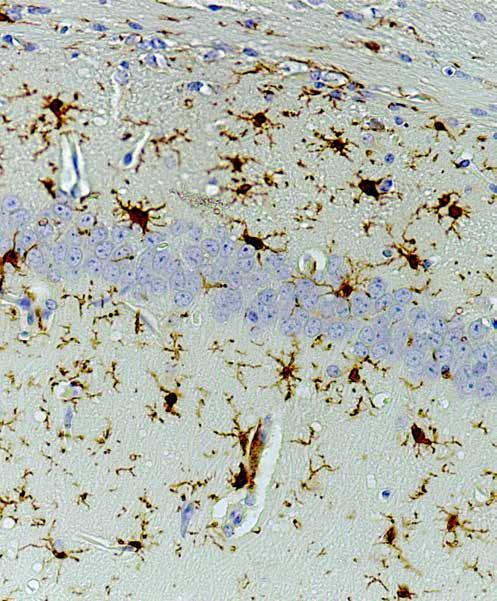
In mice without microglia, there was more harmful activity in astrocytes, their neurotoxic response was much stronger and mice developed prion disease much quicker. The rate of prion accumulation in the brain was no different, but the progress of disease was faster, compared with mice that had microglia.
These results suggest that microglia’s role in limiting the impact of disease did not involve the destruction of prions, but rather to limit the neurotoxic activity of astrocytes. Insights from the study could inform development of drugs to treat prion diseases and other neurodegenerative disorders such as Alzheimer’s disease and Parkinson’s disease.
The study was carried out with colleagues at the University of Queensland and the University of Edinburgh’s Centre for Discovery Brain Sciences and Queen’s Medical Research Institute.
Foot-and-Mouth Disease study may inform long-term vaccines
Detailed insights into how the Footand-Mouth Disease Virus (FMDV) interacts with immune cells are helping researchers understand persistent infection in some animals.
The findings, from a team at the Roslin Institute and Pirbright Institute, could inform the development of new vaccines that offer longlasting protection against the highly contagious disease. They sought to understand how the virus that causes Foot-and-Mouth Disease (FMD) is retained and persists in tissues such as the spleen following infection.
In studies in mice, they discovered that FMDV binds to cells, known as follicular dendritic cells, which are found in lymphoid tissues in the immune system. These cells behave almost like a spider’s web, trapping foreign particles and certain viruses for long periods of time so that other cells in the immune system can make immune responses against them.
Analysis showed that the virus binds to a receptor molecule, known as CR2/CR1, on follicular dendritic cells. This was found to be essential for the cells to be able to trap and retain the virus, which in turn leads to a better, and longer-lived immune response.
The scientists consider this helps the virus to persist in animals such as African buffalo and allows these animals to become carriers of the disease, which in turn poses a risk to other susceptible livestock.
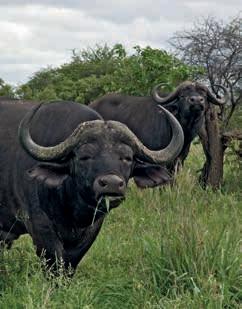
Vaccine campaign to free Indian state from rabies
Goa is on track to eliminate rabies following a seven-year charity effort, according to a study by the Government of Goa, UK-based charity Mission Rabies, the Royal (Dick) School of Veterinary Studies and its research arm, the Roslin Institute.
Efforts by a team on the ground involved the use of smartphones to capture large quantities of data on stray dogs. This guided efforts to create pop-up clinics and vaccination points where they were most needed, to prevent the spread of the disease to humans from dog bites.
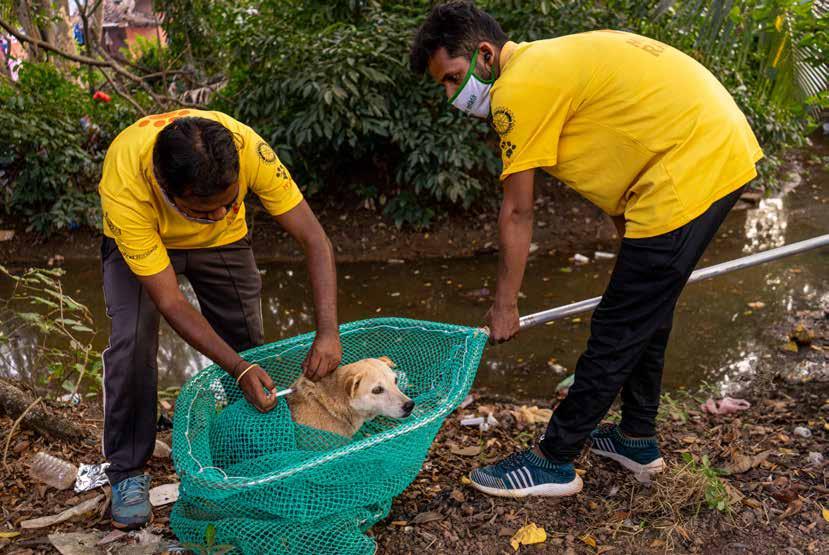
The team’s approach used the principles of One Health – considering human, animal and environmental health all together – to efficiently target infection. Their programme consisted of three core areas of activity – dog vaccination, rabies education, and intensified human and animal rabies surveillance.
The work enabled Goa to be declared a rabiescontrolled state in 2021, the first of its kind in India, following three years without any human deaths from rabies.
The latest study, published in Nature Communications, finds that Goa is on track to eliminate the disease. Lessons learned during this campaign will be vital in ongoing efforts against rabies. The approach could be applied in other states, preventing the death of millions of people.
Work was carried out in India by Mission Rabies, the Government of Goa, University of Edinburgh, Dogs Trust Worldwide, MSD and other partners.
The World Health Organization and United Nations’ Food and Agriculture Organization have set a target for global dog-mediated human rabies elimination by 2030, but examples of largescale dog vaccination programs demonstrating elimination remain limited in Africa and Asia.
Data from this paper clearly demonstrates that targeted canine vaccination campaigns, alongside education and surveillance not only eliminates rabies, but does so in a cost effective and efficient way, that relieves the financial burden faced by communities impacted by rabies.
Professor Richard Mellanby, Royal (Dick) School of Veterinary StudiesRabies vaccination campaign reaches 2 million dogs
Apublic health campaign to eliminate rabies, supported by Dick Vet Scientists, reached a milestone of vaccinating two million dogs around the world against the disease in September. The outcome, marked on World Rabies Day, was a result of the charity Mission Rabies’ mass vaccination campaigns that aim to help stop human deaths from rabies by 2030.
Work was carried out with support from partners around the world including the Royal (Dick) School of Veterinary Studies and the Roslin Institute.
To efficiently deliver canine vaccinations on a large scale, Mission Rabies use a bespoke data collection app, developed with University of Edinburgh expertise, to help with rabies and dog population research, and to ensure campaigns are effective and measurable.
The app is also used by other government bodies and NGOs to record vital data and vaccination figures.
Despite being vaccine preventable, rabies still has the highest fatality rate of any infectious disease and once clinical symptoms develop, death is inevitable.
Almost all – 99 per cent – of human rabies cases are contracted as a result of dog bites, and vaccinating dogs is the most effective long-term control strategy to protect communities.
Mission Rabies runs mass canine vaccination campaigns, surveillance, and community education programmes in the world’s worst rabies affected areas. The charity’s response teams, located in its key project sites, also offer 24-hour support for rabies emergencies.
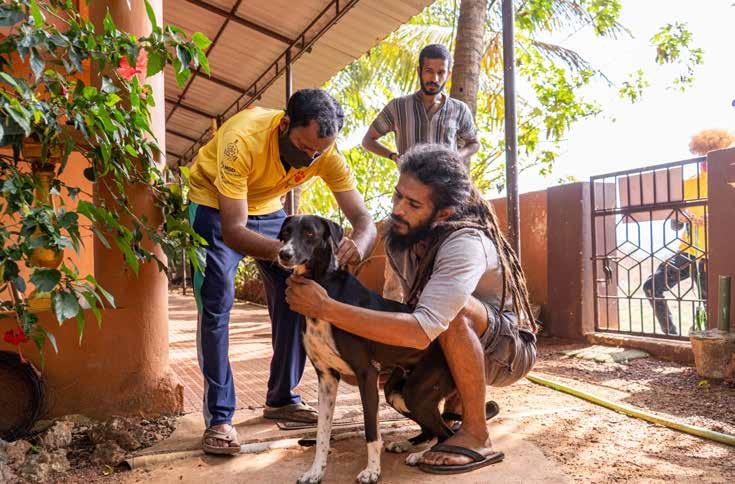
The World Health Organization and United Nations’ Food and Agriculture Organization have set a target for global dog-mediated human rabies elimination by 2030.
World Rabies Day, 28 September, marks the anniversary of the death of scientific pioneer Louis Pasteur, who administered the first human rabies vaccine in 1885.
I’m hugely proud to be a part of the Mission Rabies team and we’re all delighted with this landmark achievement. None of it would have been possible without the inspirational winners believing in the cause so a tremendous thanks to all involved and a special mention to Dogs Trust Worldwide, MSD Animal Health, the CDC and the University of Edinburgh for their phenomenal support. There is so much more we need to do, and so we need to really fire up the momentum globally if we’re going to hit the WHO 2030 goal.
Dr Luke Gamble, Founder and CEO, Mission Rabies
Severe bird flu season brings impetus to tackling virus
Adamaging, long-term bird flu outbreak has highlighted the need for scientific interventions to track and target disease in poultry.
Wild seabirds have long been a feature of Scotland’s islands and coastlines, to which they come ashore to breed. This breeding season, however, has been unlike others that have come before.

Birds such as gannets, cormorants and great skuas are dying from avian flu in colonies across the country, with wildlife charities concerned that the impact of widespread infection could lead to long-term population declines.
These wild birds are victims of the largest outbreak of bird flu to date in the UK and parts of Europe. They are among many thousands around the world to have perished in recent months, in an outbreak that has swept Asia, Africa, Northern Europe and North America. Domestic birds have also been badly affected.
“This is the biggest outbreak we’ve seen, and we don’t know why it’s happening,” says Professor Paul Digard, Chair of Virology at the Roslin Institute.
Professor Digard is one of a team of experts from around the UK seeking to find out what has changed, in a £1.5 million study of bird flu. The collaboration aims to understand how current strains are able to form larger, longer outbreaks than in previous seasons, and how the virus is able to penetrate poultry premises.
Researchers will also investigate infection and spread of disease in various bird populations, including how the virus transmits from wild to farmed birds, and why some species, such as ducks, are more resistant than others to bird flu.
The team will map and model the spread of infection over time and across species, and develop models to predict how the viruses will evolve and spread.
The consortium, known as Flu-MAP, is led by the Animal Plant Health Agency (APHA) and funded by the Biotechnology and Biosciences Research Council (BBSRC) and the UK Government’s Department for Environment, Food and Rural Affairs (Defra).
SIGNIFICANT IMPACT
Since October 2021, the H5N1 strain has caused nearly 3,000 cases in poultry in dozens of countries, and more than 77 million birds have been culled to curb the spread of the virus, according to Nature.
Seasonal strains of bird flu originate in South East Asia, from where migratory birds spread the disease to other regions, enabling infections to reach wild and domestic birds around the world during the winter season, and now, enduring through summer.
For the past four years, circulating strains of avian flu have all been classified as highly pathogenic – a type that is able to cause severe disease.
EVOLVING CHARACTERISTICS
The severity of current strains may be attributable to randomly occurring changes to the surface proteins on the flu virus, so they now match the receptors to which they attach in wild birds, which could change how the disease hits different species, Professor Digard suggests.
Alternatively, the virus may be becoming more stable in the environment, for example being able to survive in pond water over summer instead of breaking down amid warm temperatures and exposure to sunlight, he adds.
“Flu is a definitive One Health problem, affecting the environment, animals and people, and we absolutely have to consider a holistic approach,” he says.
Understanding how and why outbreaks develop and spread depends on surveillance efforts.
STUDENT INNOVATION
Veterinary student William Dabri is developing a method of tracking bird flu in the environment by sampling sediment from lochs and ponds visited by bird populations, testing for traces of virus originating in bird faeces.
Mr Dabri’s idea was inspired by an internship with the Canadian Food Inspection Agency and by discussions with a visiting researcher to Roslin, Dr Michelle Coombe of the British Columbia Ministry of Agriculture, Food, and Fisheries, whose team has developed a method of sampling bird flu from wetland sediments.
“By testing the sediment in ponds, we can test the amount of influenza that is excreted in bird faeces and the strains these birds are carrying, in real time,” he said.
“When disease strikes animals on farms that there is often very little we can do … testing is often the best tool in our kits to curb disease spread. By testing for avian influenza in ponds, we get one step ahead of this virus.”
The development comes at a critical time, when infections run in high numbers. It may subside in future, when sufficient numbers of birds have survived infection and herd immunity is reached, or the virus may evolve to lose its predilection to affect seabirds. However, research continues to be vital.
“This disease will become less damaging,” explains Professor Digard. However, he cautions, we cannot afford to disregard its potential to reinvent itself. Avian flu potentially may spill into other species –such as people, sea mammals or wild land mammals. With this in mind, it is important that society, and science, continues to prepare for future outbreaks.
Infection and ImmunityPandemic research team to develop lung disease drugs
Amulti-million pound research programme is underway to develop treatments for lung infections and to prepare for future pandemics. Scientists will use translational genomics and experimental medicine methods to speed up drug discovery.
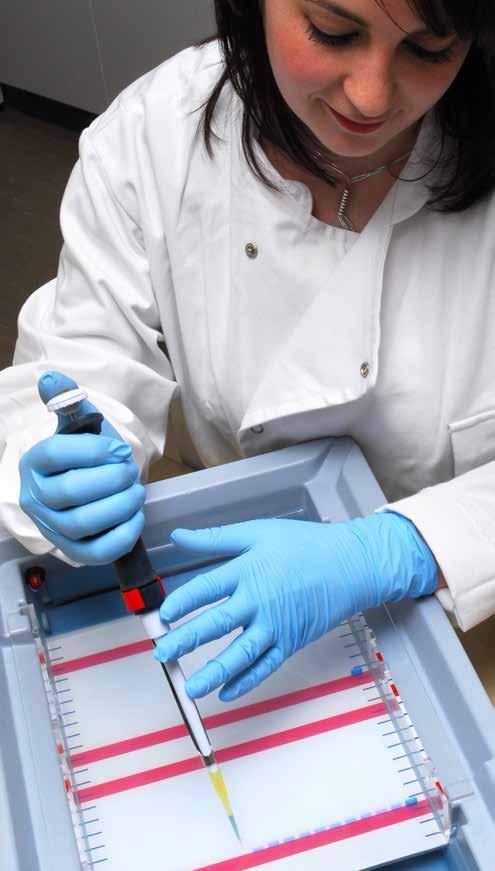
The University of Edinburgh’s Baillie Gifford Pandemic Science Hub will use clues from the human genome to identify and rapidly test new treatments. It will also use experimental medicine methods to quickly evaluate and develop drugs for lung inflammation and injury caused by infection.
The hub will combine the ability to determine a person’s genetic predisposition to lung injury with advanced interventional robotics for drug delivery, sensing and sampling technologies, and clinical trial design.
It will bring together expertise from two large experimental medicine consortiums led by the University, known as GenOMICC and STOPCOVID, with a focus on critical care patients.
GenOMICC, led by scientists from the Roslin Institute, has found 17 genes underlying severe Covid-19, leading to new drug treatments which can reduce the likelihood of death from Covid-19 infection. STOPCOVID has established pathways for testing therapies in patients alongside accelerating technologies for delivering and measuring drugs in human lungs.
Baillie Gifford is supporting the launch with a £14.7 million donation. The University aims to secure a total of £100m investment to accelerate discoveries to drive treatments, partnerships and translational opportunities with academic organisations, industry and other collaborators worldwide.
To quicken the discovery of new treatments, the team will deliver microdoses of multiple medicines to key areas of patients’ lungs and observe whether the drugs work on their own or in combination. The constant risk of respiratory viruses, combined with the emergence of antibiotic resistance in respiratory diseases, means a radical new approach to streamlining drug development and evaluation is needed.
To deliver this vision the hub will harness the expertise of the University’s leading data scientists, roboticists, engineers, chemists, biologists, regulatory experts, drug developers, toxicologists, translational managers and clinicians.
Sustainable Agriculture
Study aims to produce lice-resistant salmon
Scientists from the Roslin Institute and University of Stirling aim to identify genes that could make Atlantic salmon resistant to sea lice; parasites that severely affect fish health and welfare, and cost the global aquaculture sector around £800m per year.
Researchers aim to pinpoint key genes and associated biological processes underlying genetic resistance to these parasites. This will include studying the response to lice attachment exhibited by coho salmon, a species of salmon which is fully resistant to sea lice, and then applying knowledge gained concerning mechanisms of resistance to Atlantic salmon, which is susceptible.
The project will receive a total of £1.7 million from the Biotechnology and Biological Sciences Research Council (BBSRC) and the Sustainable Aquaculture Innovation Centre (SAIC). It is an industrial partnership award with aquaculture breeding company Benchmark Genetics.
The researchers will use data previously collected from 12,000 infected fish to identify regions of the salmon genome associated with resistance
to sea lice. They will also compare Atlantic salmon with coho salmon to investigate the key mechanisms, genes and proteins involved in their different responses to lice.
Gene editing will be used to validate and shortlist genes and processes that could be linked to resistance, through tests examining the effects of silencing genes of interest. The method, which enables targeted, precise changes to the genetic code, has been used in previous studies by scientists from the Roslin Institute to identify disease resistance genes in salmon, and has potential applications in aquaculture breeding to improve health and welfare traits.
Alternative control strategies, such as feed supplements, cleaner fish, and tailored cage design, are only partially effective and some lice are developing resistance to drugs. Selective breeding to increase resistance of salmon to lice is an effective but relatively slow process because a generation of salmon takes up to four years to reach maturity for reproduction.
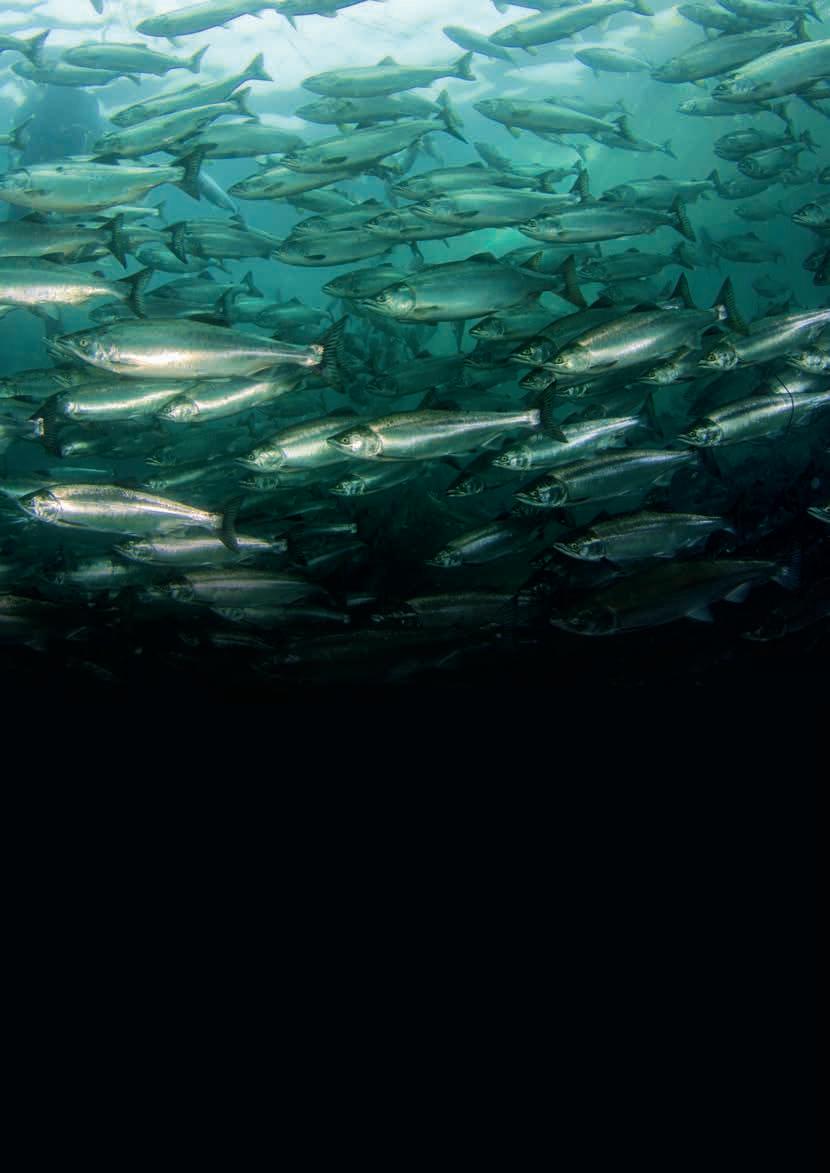
Ministerial visit to Agritech Hub highlights data potential
Ahead of her visit, the minister opened the A3 Scotland Conference on Animal Health, Agritech and Aquaculture, with a focus on net zero.
Stakeholder study seeks to map future of UK livestock
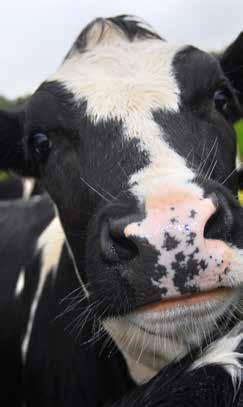
Jo Churchill, Minister for Agri-Innovation and Climate Adaptation at the UK’s Department for Environment, Food & Rural Affairs (Defra), visited the Easter Bush Agritech Hub in April 2022.
During the visit, the Minister met with senior staff including Professor David Argyle, Head of the Royal (Dick) School of Veterinary Studies, and Professor Bruce Whitelaw, Director of the Roslin Institute, touring some of the worldleading facilities on campus.
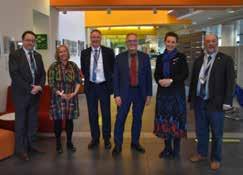
The group discussed the potential of datadriven innovation to improve the efficiency of food production, accelerate the path to zero carbon, and reduce emissions – with a view to ensuring animal health, robustness and welfare.
While onsite, the Minister saw gene-edited cattle with improved heat tolerance.
This scientific technique was used in a study by researchers from the Centre for Tropical Livestock Genetics and Health (CTLGH) at the Roslin Institute. It could benefit cattle in tropical low- and middle-income countries, where increased temperatures associated with climate change have negative impacts on animal welfare, productivity and immunity.
The Easter Bush Agritech Hub is a dynamic and vibrant innovation environment. World-class facilities equipped with the latest technologies support Europe’s largest concentration of animal science research experts and clinicians, as well as co-located industrial partners in the custombuilt Roslin Innovation Centre. In partnership with the Edinburgh International Data Facility delivering exascale supercomputing at Easter Bush, the Agritech Hub will propel data-led decision making in the Agritech sector.
Minister Churchill visited the Roslin Institute, a world-leader in animal bioscience research; the Large Animal Research and Imaging Facility (LARIF), which provides insights into livestock and human health through the study of large animals; and the Roslin Innovation Centre, which provides laboratory and office space for animal and veterinary science start-up companies.
ABOUT THE EASTER BUSH AGRITECH HUB
An efficient agricultural sector is critical to social wellbeing; by 2050, global agricultural production will need to increase by 50 per cent to feed a growing global population. By applying data technologies that enable farmers and related industries to improve food production and veterinary care, digital agriculture – known as agritech – will be critical to increasing global food supply.
The Easter Bush Agritech Hub seeks to leverage existing world-class research institutes and commercialisation facilities to become a global centre of Agritech and veterinary excellence. It boasts a campus-wide network that can generate and collate, in real time, a multitude of local and global data, such as veterinary activities, animal genetics, food species genetics, soil condition, weather and market drivers.
It can also collaborate with partners, using this information to realise the potential of having the right food species, and the right products, in the right field at the right time, to maximise agricultural productivity.
A project led by the Global Academy of Agriculture and Food Systems will work with stakeholders in UK livestock to seek consensus on the sector’s increasingly contested role in the economy, against a backdrop of climate change targets.
The scientists will engage with farmers, retailers, policymakers and others, aiming to balance the sector’s market value and opportunities for innovation with its less tangible contributions to food systems, health, rural economies and social wellbeing.
The three-year initiative will aim to define an agreed pathway to transform UK livestock in readiness for a changing future, while sustainability in UK livestock is called into question over the environmental and health impacts of meat and dairy production and consumption.
The project, named TRAnsforming the DEbate about livestock systems transformation (TRADE), will also involve scientists from the Roslin Institute and is funded by UK Research and Innovation’s Transforming UK Food Systems Strategic Priorities Fund.
We were delighted to host Jo Churchill at the Agritech Hub to discuss data-driven innovation and explore how we can work with Defra to unlock national data assets. The unique concentration of expertise and capabilities we have at Easter Bush enables us to be truly innovative in our approach to many of the world’s most pressing problems around hunger, nutrition, disease and planetary health.
Professor Bruce Whitelaw, Director, Roslin Institute
Natural farming programme halves use of pesticides by farmers
Moves to transition farms in an Indian state to organic practices have reduced pesticide use among farmers, a study led by the Global Academy of Agriculture and Food Systems has shown.
Improved training of both farmers and retailers, increased support from government agricultural representatives, and moves to limit the availability of pesticides could help the state of Andhra Pradesh become all-organic by 2030, the study shows.
Researchers from the UK, India and US, led by the Global Academy of Agriculture and Food Security, sought to assess the impact of the APCNF programme, which aims to transition 8 million hectares of farmland, belonging to 6 million farmers, to organic by the end of the decade.
Interviews with more than 850 farmers and almost 40 retailers showed that despite the major government drive towards organic agriculture, about half of organic farmers still used pesticides and there had been no impact on pesticide sales at local retailers.
The study included almost 150 farmers who had been practising organic farming for an average of two years. These farmers were less likely to use pesticides than conventional farmers, although pesticides continue to be used. Farmers who met government agricultural extension workers more frequently were less likely to use pesticides, underscoring the importance of training, researchers found. In the absence of training, when there is a pest outbreak, farmers who are new to organic practices may quickly default to the familiar use of pesticides, which are readily available from retailers.
The study, published in The Lancet Planetary Health, is the first to evaluate the impact of a large-scale government organic agriculture programme on pesticide use and availability. It was carried out in collaboration with the Public Health Foundation of India, Harvard TH Chan School of Public Health, and Centre for Chronic Disease Control, India, and supported by the Scottish Funding Council and UK Research and Innovation.
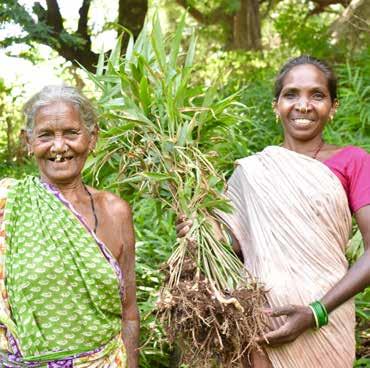
Low-cost freezing method to safeguard indigenous poultry
Alow-cost freezing technology can safeguard the genetic diversity of indigenous chickens in low- and middle-income countries, a study based at Roslin has found. Chicks have been born from surrogate chickens that received formerly frozen reproductive cells extracted from embryos, derived entirely from donor chickens.
The cryopreservation method could help preserve the 1,600 local chicken breeds that are an important source of income for smallholder farmers in tropical countries. It could also help secure poultry genes from indigenous breeds for efforts to develop birds with climate resilience or disease resistance and to ensure food production.
A team from the Centre for Tropical Livestock Genetics and Health (CTLGH) and the Roslin Institute, with their commercial partner Cobb-Europe, validated a simple technique in which chicken reproductive organs were extracted from embryos, pooled by sex and frozen. After being thawed, the reproductive cells were injected into sterile surrogate embryos. Male reproductive cells were injected into male embryos, and female cells into female embryos.
Research using fluorescent proteins to label the donors’ cells and a method to control the reproductive genes carried by both parents – known as Sire Dam Surrogate mating – demonstrated that chicks were derived entirely from their donor parents.
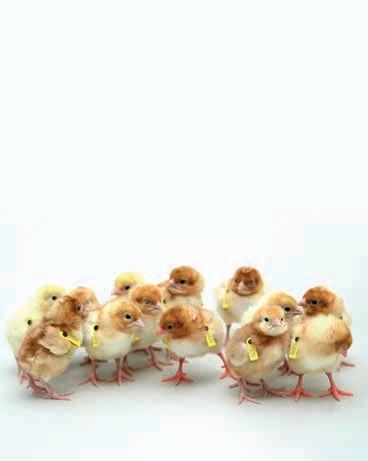
Dr Tuanjun Hu, the Roslin Institute and CTLGH
The study is published in the journal eLife and was funded by the Bill & Melinda Gates Foundation, the UK Foreign, Commonwealth and Development Office under the auspices of CTLGH, and the National Centre for the Replacement, Refinement, and Reduction of Animals in Research.
“This simple, low-cost and low-tech biobanking method will be beneficial to poultry breeders worldwide, big or small. It will reduce the cost of maintaining livestock for breeding, and will benefit the welfare of chickens by reducing the number of birds in research facilities.”
Insight into sales messaging could aid seafood trade
eafood marketing messages vary between different regions of the world, according to research involving the Global Academy of Agriculture and Food Security.
A team of researchers led by the University of Stirling studied logos, certification and claims on exhibitor booths at seafood trade show events in China, Europe, and the US.
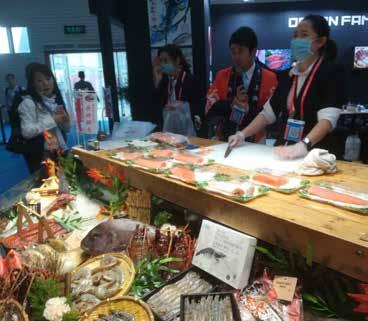
They found a clear difference in approach between the Global South and North. Chinese messaging focused on food safety and the quality of the product, while European and North American consumers were perceived to be more interested in the sustainability of production processes.
Their findings are published ahead of the first global seafood trade show of the year, Seafood Expo North America in Boston, US, later this month.
Project partners included the Global Academy, Kafrelsheikh University, South China Sea Fisheries Research Institute, Shanghai Ocean University and the University of Massachusetts Boston. The study was carried out as part of the Green Aquaculture Intensification Project (GAIN), funded by the European Commission’s Horizon 2020 programme.
Gene insights could aid African food systems
Insights into the DNA of plants, animals, and other organisms that are endemic to Africa would help understand the continent’s biodiversity, a consortium including scientists from the Roslin Institute has said.

The African BioGenome Project (AfricaBP), a consortium of African scientists and organisations, called for efforts to decipher and study the genomes of more than 100,000 endemic species.
This would enable better understanding of resources that are crucial to regional food security, and help build resilience in breeding, sustainable food systems, and biodiversity conservation across the continent, the team says.
Providing the required technology and training to local scientists is the most efficient way to improve resilience and sustainability of food systems in Africa, researchers say. AfricaBP will work with policymakers on recommendations for legislation governing national access to resources, to ensure equitable sharing of the gains obtained from its activities.
The project’s objectives would deliver on the goals of the post-2020 Global Biodiversity Framework of the Convention on Biodiversity, and the United Nations’ Sustainable Development Goals, while complementing efforts by the Human Hereditary and Health consortium.
Novel approach could aid selective breeding in cattle
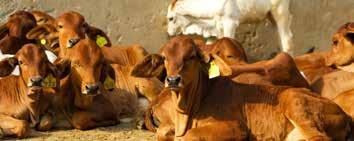
Roslin researchers and commercial partner Annogen are developing a method of identifying specific letters in the DNA code that govern the development of key physical traits, such as productivity or disease tolerance, in livestock.
The researchers will use a high-resolution approach to precisely identify sections within the DNA code that behave like switches to directly control gene activity. These switches, known as regulatory elements, govern whether individuals will exhibit the characteristics associated with a particular gene.
Their approach will use a technology, provided by Annogen, that improves on low resolution techniques that spot only the broad regions
of DNA in which these regulatory variants reside. This technology, known as Survey of Regulatory Elements (SuRE), helps to identify those variants and mutations that can be linked to key physical traits, such as productivity or disease tolerance, in livestock.
Insights from the study could aid the use of gene-editing technology targeting these regulatory variants to give rise to the preferred traits in livestock.
Scientist adds voice to UN climate change report
An expert from the Global Academy of Agriculture and Food Security has been involved in the latest report from the Intergovernmental Panel on Climate Change (IPCC), the branch of the UN responsible for assessing human-led climate change.
The new findings highlight the vulnerabilities of the world’s socioeconomic and natural systems to climate change, its wide-ranging consequences and options for adapting to it. They warn that many changes to the climate are likely to be irreversible, and that they are unequivocally the result of human actions.
Among the Edinburgh contributors to the new report is Dr Peter Alexander, Senior Lecturer in Global Food Security, whose research looks at the interface of social, economic and ecological aspects of land use, was a lead author of a chapter about Europe.

One of the chapter’s key findings is that the current global temperature increase of 1.1°C is already affecting natural and human systems in Europe. This can be seen in ecosystems, food systems, infrastructure, energy and water availability, the economy and public health and wellbeing, Dr Alexander says. However, there is scope to adapt to many climate risks, although these become more limited the further 1.5°C global warming is exceeded.
Improved DNA reference aids African cattle research
Aresearch team led by Roslin has created an improved reference genome, detailing the DNA of a variety of cattle, which can be used to underpin research into genes and other elements of DNA governing key traits for livestock.
For the first time, the genome incorporates information from key African cattle breeds. This includes sections of genetic code not found in the European breeds on which earlier versions of the reference genome were based.
The more globally representative DNA reference is intended to support research in a range of cattle breeds. It may be especially useful in aiding understanding of breeds from Africa, for which scientific resources are limited, despite the animals’ economic significance.
The team, consisting of researchers from the Roslin Institute, the International Livestock Research Institute and the Centre for Tropical Livestock Genetics and Health, determined the genetic code for two breeds of cattle common to Africa – the N’Dama and Ankole breeds.
Genomic details for these African breeds were integrated with existing data on three European breeds to create the globally relevant new reference genome. The Ankole and N’Dama cattle were found to have portions of DNA not present in European breeds, the study has found.
The study, published in Nature Communications, was supported by the Biotechnology and Biological Sciences Research Council, which is a part of UKRI. This research was also funded in part by the Bill & Melinda Gates Foundation and with aid from the UK Foreign, Commonwealth and Development Office.
Agricultural universities team up on research plan
More than a dozen universities that offer courses in agriculture and carry out agricultural research have formed a council to agree on joint agricultural research priorities, working with farmers and others who have a stake in the industry’s future.
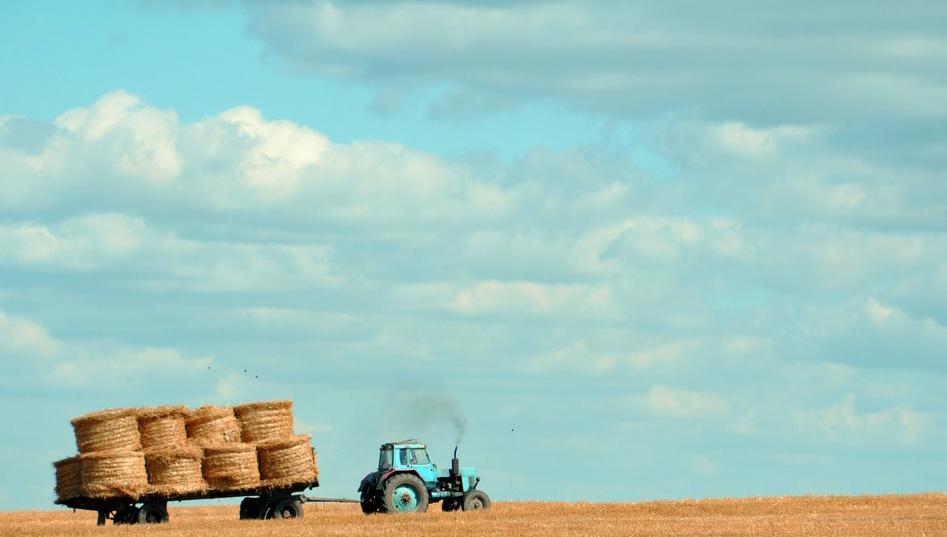
Sixteen universities, including the University of Edinburgh, form the Agricultural Universities Council (AUC), which will engage with all four Governments in the UK in its ongoing work.
With farming in the UK currently going through a rapid transition, the initiative responds to calls for more joined-up research and to ensure public investment in agricultural innovation makes a difference on the ground.
The Council’s first project will be to map existing agricultural research capacity across the UK for the first time in a decade, and
work with farmers, as well as environmental, welfare and community groups, food businesses, and other stakeholders, to shape future research priorities.
“We’re pleased to be part of the Agricultural Universities Council and look forward to collaborating with other UK agricultural institutions on education and research for farmers and the agri-food sector.”
Professor Geoff Simm Director, Global Academy of Agriculture and Food Security
Data science applied to key food systems challenges
Scientists support efforts to define urgent data science questions for food systems sustainability.
Researchers are taking part in an initiative to identify urgent challenges in ensuring sustainable food systems, which can be tackled with help from data science.
The project, led by an international collaboration, seeks to identify the 10 most impactful research questions that could be investigated to make food systems healthier.
Researchers from the Global Academy of Agriculture and Food Security have contributed to the venture, coordinated by The GovLab of New York University along with think-tanks the Barilla Foundation and the Brussels-based Center for European Policy Studies.
Members of the public are invited to input to the project by voting for action on issues encompassing the use of data science in food production, distribution and consumption.
TOPICAL ISSUES
The scheme forms part of the 100 Questions initiative, which aims to define problems across a range of topics that may be addressed with improved access to data and application of data science.

Food-based questions may help address imminent problems focused on inequality in distribution and access, lack of education on healthy eating, and unsustainable farming, as the global population is forecast to reach 11 billion by 2050.
Researchers involved in the 100 Questions project worked with food science, security, and climate strategy experts to formulate questions based on overarching themes in food systems sustainability.
Members of the public may vote for the questions they think should be prioritised, at the 100 Questions website.
Contract tracing tool supports supplies during pandemic
Adigital contact tracing tool has been developed to help counteract supply chain delays linked to Covid-19 in East Africa.
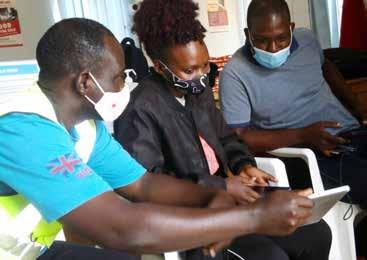
A multidisciplinary team, led by the Roslin Institute with colleagues in Uganda, consulted with key stakeholders to devise the opensource tool tailored to haulage use in developing countries.
The team’s intervention follows severe delays at Uganda’s ports following the introduction of mandatory Covid tests for drivers, after a majority of cases at the peak of the country’s first Covid-19 wave were linked to the sector.
The newly devised protocol uses mobile phone technology to integrate data on the road network infrastructure, time-stamped geopositioning, and Covid-19 test result data for drivers, to increase the speed and accuracy of public health contact tracing in the region.
The study will allow the research team to develop informative models that map the risk of Covid-19 disease and transmission, and to estimate the contribution of haulage to Covid-19 epidemiology in Uganda. It will also collect feedback from truck drivers and other key participants, to review potential benefits and limitations of the technology.
This is the first study that fully documents the development of a Digital Contact Tracing (DCT) tool in consultation with stakeholders on the African continent.
The research, funded by the Medical Research Council, also involved researchers at the University of Edinburgh’s School of Informatics.
Digital contact tracing (DCT) can be an effective way of supporting public health and societies at a time when supply chains are critically important. Here we use technology embedded within mobile phones to deliver an anonymised, ethical and legal approach to implementing DCT tailored for haulage to control infectious diseases, including but not limited to Covid-19 in the Global South.”
Dr Adrian MuwongeRoslin Institute“Data science has huge potential in helping us understand and resolve some of the biggest challenges facing society today. The 100 Questions initiative offers a novel approach to highlighting food system sustainability issues that researchers and the wider public deem to be most pressing, and in forming partnerships to tackle these.”
Professor Geoff Simm, Director, Global Academy of Agriculture and Food Security
DNA discoveries could aid oyster success
Scientists from the Roslin Institute have developed extensive genetic resources detailing the DNA of oysters and used them to help address the challenges this species faces in terms of conservation, restoration and aquaculture.
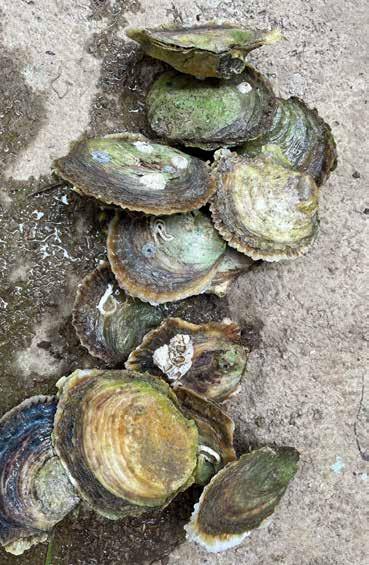
Two areas of the oyster genome are significantly associated with faster growth, the researchers have found. The incorporation of genomic information into breeding schemes could be a cost-effective way of enhancing growth traits such as weight and shell size in oysters, scientists concluded.
To help understand all the genetics information in their studies, the researchers decoded the complete DNA code of the European flat oyster. Two high-quality reference genomes were separately built to the chromosome level by the Roslin team and scientists from Sorbonne University in France.
This research concluded that it is feasible to genetically improve growth traits in oysters. Both genomes have been published and are already being widely used by oyster researchers in Europe.
A separate study, led by scientists from the University of Santiago de Compostela and involving Roslin experts, discovered that variations in a region of oyster DNA may be associated with tolerance to the deadly parasite Bonamia ostreae.
Insects offer sustainable, nutritious food source
Insects offer a nutritious food source for humans, and are efficient and sustainable to produce, according to a report by a Global Academy researcher.
Consumption of insects is growing in popularity, and there are more than 2,000 edible varieties available, says Dr Peter Alexander. Insects’ high protein and mineral content helps to explain why they already feature in the diets of people in many parts of the world, he explains.
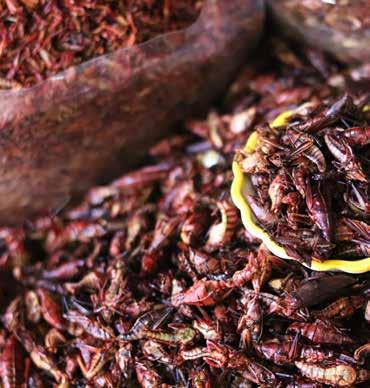
Cultivated insects can convert their feed into energy more efficiently than conventional livestock animals, and a larger portion of the animal can be eaten, according to the report. Insects also breed more frequently than most farmed animals, producing many generations in a year, and take up a relatively small land area.
They also offer the benefit of consuming feed from some byproducts or food waste, contributing to a circular food system.
Dr Peter Alexander, Global Academy of Agriculture and Food SystemsThe acceptability of foods can change over time. Tomatoes were regarded as poisonous in Britain and dismissed for over 200 years. Lobsters, now an expensive delicacy, were formerly so abundant in the US that they were served to workers and prisoners and were commonly used as fertiliser and fish bait.
Pandemic’s first wave had minimal impact on farming pattern and practices in India
Indian farmers experienced disrupted labour, supply chains, and access to credit and markets owing to Covid-19, but did not significantly shift their cropping patterns and cultivation practices, research led by the Global Academy and Council on Energy, Environment and Water shows.
The research examines the impact of the coronavirus pandemic in a nation where nearly half of the population works in agriculture, in a system largely based on input-intensive monocropping of staple crops.
Researchers interviewed more than 3,500 farmers across India following the first wave of coronavirus, in December 2020 and January 2021, to understand how the pandemic had impacted on farmers’ choice of crops planted and their adoption of sustainable agricultural practices.
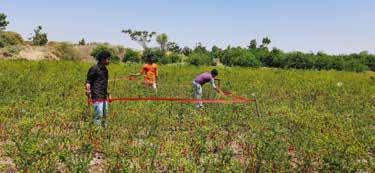
The team expected that the high cost and limited availability of fertiliser and pesticides, coupled with consumer demand for organic and healthy food and variable availability of agricultural labour, might have led some farmers to consider organic farming, natural farming, and other sustainable agricultural practices.
While most farmers – 84 per cent – reported no change in the types of crops they grew, about one-third reported a change in fertiliser or pesticide use, and many farmers expressed an interest in learning more about sustainable farming practices.
The study, supported by the Royal Society of Edinburgh, the Scottish Government, and Medical Research Council/UK Research and Innovation, was carried out in collaboration with partners in India and Monash University, Melbourne, Australia
National event on food security challenges
Barriers to food security, and how these could be resolved, were discussed by the Director of the Global Academy of Agriculture and Food Systems at an industry event in 2022.
Professor Geoff Simm joined senior politicians and representatives from across the agricultural sector at the meeting of the UK Agricultural Partnership, a forum created by the UK Department for Environment, Food & Rural Affairs, which brings together farmers, researchers, businesses and policymakers across the UK.
In a talk entitled ‘Food Security research and innovation’, Professor Simm outlined the role that research and innovation can play, and their limits.
As part of a panel discussion focused on solutions, he emphasised the need to tackle food insecurity in a systemic manner, along with the intersecting challenges of climate change, nature and loss of biodiversity, malnutrition & inequity, at local and global levels.
Professor Geoff Simm Director, Global Academy of Agriculture and Food SystemsRadiography could transform poultry breeding
Afast, safe method of analysing bone density in live hens could help poultry producers select the optimum birds with which to breed, to improve animal health and welfare.
Scientists at the Roslin Institute have developed a digital X-ray procedure that takes around 45 seconds to conduct, is practical for hens and poultry workers, and delivers reliable, reproducible results. Their novel method enables breeders to consider bone density in their selection of laying hens, which are at risk of fractures from biological changes linked with laying eggs.
Recent advances in digital X-ray technology have enabled researchers to develop their technique to capture and interpret images relating to bone density. Their method involves quickly capturing digital X-rays of live hens, from which their leg bone density can be calculated, and data digitally shared. Researchers optimised their method to ensure a
clear image in minimal exposure time. Their approach was validated by comparing results from chicken X-rays with those from analysis of chicken leg bones.

The procedure, which takes about 45 seconds, offers a fast, practical alternative to conventional imaging techniques such as Dual-energy X-ray Absorptiometry, Digitised Fluoroscopy and CT scans.
Strong bones offer improved health and reduced risk of fractures in birds that have freedom to move around their environment. The keel bone, or sternum, of hens is particularly prone to damage and previous research by the same team has shown that leg bone density is genetically related to that of the keel bone, and to fracture risk.
A practical way to measure bone density could also help reduce the number of animals needed for research into nutritional and management aids for bone health.
Food security is a complex local and global challenge that calls for interventions from a range of angles, including social, economic, and political, as well as technical contributions. It is vital that all relevant parties come together to develop systemic solutions.
Varied red meat intake offers scope for alternatives
Americans’ consumption of red meat is not dominated by any single food type, research has shown, offering potential opportunities to encourage consumers towards alternatives.

A team of researchers including scientists from the Global Academy of Agriculture and Food Systems analysed data from the US National Health and Nutrition Examination Surveys from 2015/16 and 2017/18. They examined meat intake for 12-19 year-olds and adults of 20 and upwards.
Analysis of consumer eating habits from recent nationwide surveys shows that unprocessed red meat was most popularly eaten in the form of burgers, non-minced beef and mixed meat dishes such as meatloaf and shepherd’s pie. Cold meats, sausages and frankfurters, pizza, and bacon were the most widely eaten forms of processed meat.
The findings may inform efforts to encourage people towards alternatives to red meat. This would help reduce average intake, currently around 450g per adult each week, towards the recommended limit of 100g each week.
Efforts to encourage people to eat less red meat could initially focus on meat-free alternatives to burgers and pizzas, sausages and hot dogs, and lunch meat sandwiches, the results suggest. This might be supported through the development of plant-based sandwich meats and pepperoni, or greater uptake of other plant-based proteins such as beans or peanut butter.
Eursafe event focused on transforming food systems
Researchers from across Europe and beyond met in Edinburgh in September to share the latest thinking on ethical, societal and policy issues around agriculture, agricultural biotechnologies, aquaculture, animal use, food and the food supply chain.
More than 90 presentations at the European Society for Agricultural and Food Ethics (EurSafe) conference focused on the need to transform
food systems effectively, ethically and sustainably, to meet the multiple challenges of feeding a growing population without exacerbating the climate emergency.
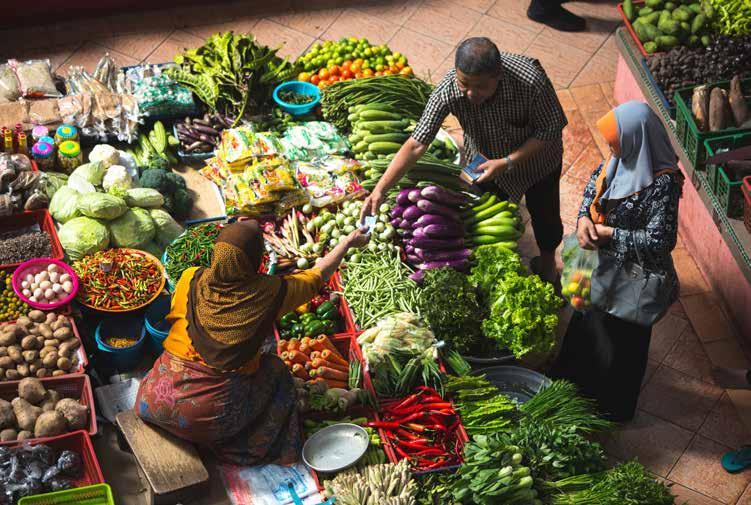
At the opening reception at the University of Edinburgh’s Old College, Mairi Gougeon, Scottish Government Cabinet Secretary for Rural Affairs and Islands, emphasised the importance of maintaining high standards of animal welfare.
Plenary sessions included a presentation by Professor Geoff Simm, Director of the Global Academy of Agriculture and Food Systems, entitled: ‘How will we feed 11 billion people sustainably and ethically?’ Professor Bruce Whitelaw, Director of the Roslin Institute, also spoke about the opportunities that new technologies offer for improving the sustainability of the food supply.
Topics covered elsewhere at the conference included research on food governance, animal ethics, land ethics, novel foods and genome editing. Among the themes that were explored were the generation of local food identities, ways to ensure the inclusion of missing voices in the debate of planetary boundaries, the acceptability of novel foods and their nutritional value.
The conference also covered sessions on animal breeding, supply chains, food waste and veterinary education and practice, and further ethical aspects of transforming food systems, including the use of antimicrobials and rewilding.
CTLGH award helps bring genetic gains to smallholders
The Centre for Tropical Livestock Genetics and Health has been awarded a further US$17.4 million of funding to support its work over the next five years in bringing the benefits of research in genetics to livestock production in low- and middle-income countries (LMICs).
The launch of CTLGH’s new phase was announced at an event at ILRI’s headquarters in Nairobi, Kenya, in September.
Building on the success of the first phase of CTLGH’s work, the organisation has been awarded US$14m from the Bill & Melinda Gates Foundation and US$3.4m from the UK Government via the Foreign and Commonwealth Development Office (FCDO).
The funding will be applied in partnership with a global network of farmer-facing organisations, to deliver the benefits of genetic gains in dairy cattle, poultry and other livestock.
Experts at CTLGH’s nodes in Scotland, Kenya and Ethiopia will seek to apply insights from research into genetics to enable purpose bred animals that are more productive, healthy, feed efficient and resilient to
climatic and environmental challenges, helping the livelihoods of tropical livestock producers.
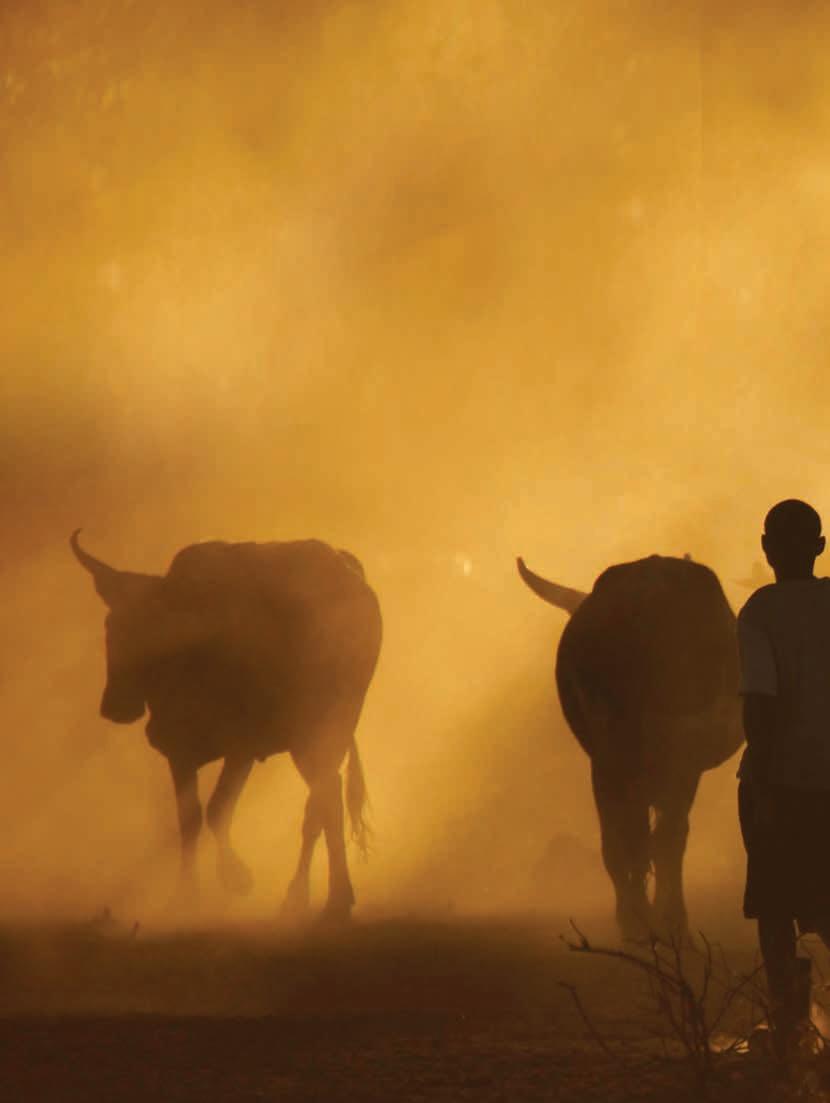
The funding tranche supports CTLGH’s current strategic plan, which will focus on the development of tools and innovations for resilient livestock smallholder systems over the next decade.
CTLGH’s founding partners – the Roslin Institute at the University of Edinburgh, which is part of the Dick Vet; Scotland’s Rural College (SRUC) and the International Livestock Research Institute (ILRI) – will focus on research, capacity building and knowledge exchange to leverage partnerships and deliver strategic objectives.
CTLGH was established to harness advances in genetics, genomics, animal breeding and data science that are driving and sustaining genetic progress in advanced economies, and apply them to livestock production systems in low- and middle-income countries (LMICs).
Currently, 1.2 billion people around the world rely on livestock for income and food security; it is important for poverty alleviation and economic development. CTLGH is working to leverage the best of the science that the Roslin Institute, SRUC and ILRI can offer, and put that into the context of livestock development for smallholder farmers. Healthy, productive livestock that are equipped to withstand a changing climate and environment helps to realise the United Nations’ Sustainable Development Goals by enabling more efficient, resilient production systems in which fewer livestock are needed. We look forward to making a positive impact by translating discoveries from the lab into tangible benefits for many.
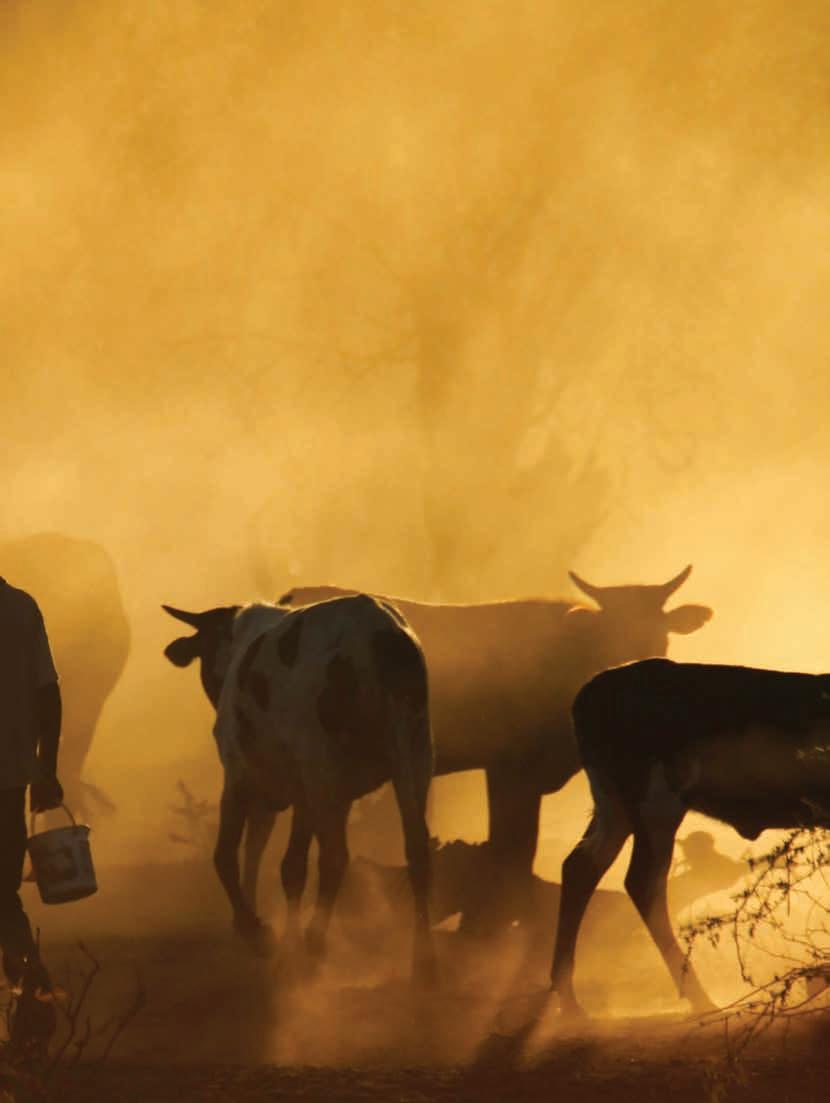
Human and Animal Health and Welfare
DNA offers insights into pig muscle development
nalysis of pig DNA has offered insights into muscle growth, in a development that could provide tools to help predict growth in piglets and support pig breeding programmes.
Researchers from the Roslin Institute and the Centre for Tropical Livestock Genetics and Health sought to find and examine regions of DNA that regulate muscle development in piglets.
The team used a technique to study DNA in frozen tissue. They applied this to samples from muscle in piglets at various stages of development, to pinpoint regions of DNA that control activity in genes linked to muscle growth, and to study activity in these genes.
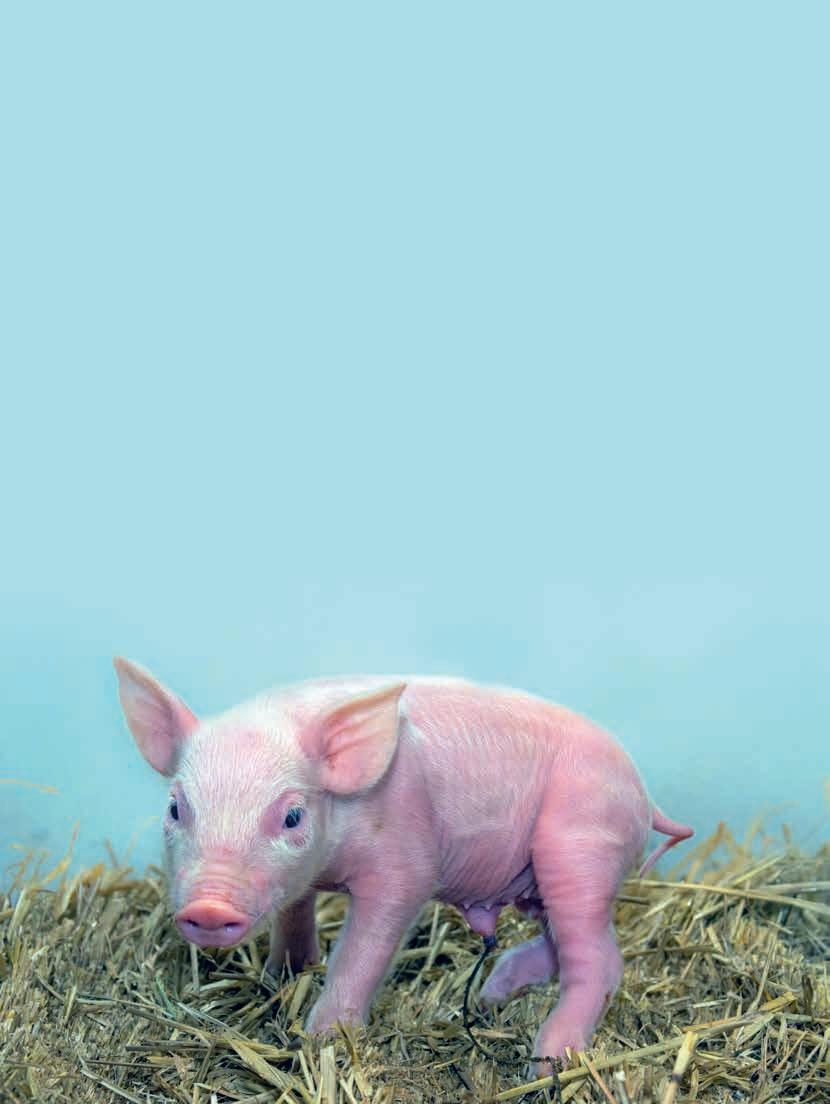
Variations in regions of DNA were observed between small and large piglets. These variations suggest a difference in how DNA is regulated –which in turn governs muscle growth – between large and small piglets.
The team’s method of analysis using frozen tissue could be applied to investigate how the genetic code of livestock controls their characteristics. As the method can be used on samples from frozen tissue banks, this could help limit the numbers of animals used for research.
Findings from the study could help use information about the genetic code to predict muscle growth in developing pigs, to ultimately produce litters with fewer very small piglets. The improved knowledge of pigs’ genetic code will also underpin research into other areas of their development, health and welfare.
Gene hampers foetal growth in pigs, study finds
uscle development during foetal growth in mammals is impaired by abnormal regulation of a gene, a study led by scientists at the Roslin Institute shows.
Levels of the gene, known as KLB, are higher than normal in foetuses that experience impaired growth in the womb. Working together with a hormone called FGF21, the gene suppresses the activity of a protein, known as mTOR, which is crucial to normal cell growth, survival and metabolism. This has a negative effect on muscle-forming cells and causes a reduction in muscle growth, the study found. These effects of KLB on muscle cells occur in both pigs and humans, suggesting the gene plays a vital role in regulating muscle development and function in mammals.
Findings from the study could inform strategies to manage the condition, known as intrauterine growth restriction (IUGR), which causes life-long ill health in animals and people.
The outcomes could also be applied to increase sustainability of pig production by reducing the effects of this gene, which results in accumulation of fat rather than muscle in affected animals and thus reduces profits to pig producers.
Dr Xavier Donadeu, the Roslin InstituteFoetal growth restriction is an important cause of newborn disease and death in humans and domestic animals, particularly in pigs. Our results help understand this condition, informing the next steps towards improving life-long welfare in affected individuals. They could also help inform methods to ensure health of pig herds.
Pig studies aim to inform dementia treatments

Pig heart valves have been transplanted into humans for many years, and insulin recovered from pigs was used to treat diabetes until the late 1980s. More recently, advances have involved transplants of the heart of a genetically modified pig, and a pig kidney, into human patients.
The animals’ contribution to medicine is now moving beyond organ donation and into scientific research. Pig studies could enable scientists to better understand the biological processes involved in human diseases, and point towards potential treatments. They offer insights into brain vascular disease that could not be obtained from conventional lab rodents. Previous research with pig models has informed management of heart disease and heart attacks.
A team involving scientists from the Roslin Institute, led by St George’s University of London, is to develop and study pigs affected by microvascular disease. This condition is characterised by damage in small blood vessels, which affects the brain, heart and other organs, and is widespread among older people. In the heart it can cause the painful condition angina, and in the brain, small strokes and dementia.
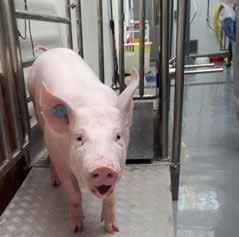
Diabetes drug has potential to treat hardened arteries

Astudy by scientists at the Roslin Institute and University of Edinburgh medical experts has determined the biological process by which the drug metformin is able to protect blood vessel cells against calcification of the arteries, a symptom of many cardiovascular conditions.
The team’s study followed previous research that showed that metformin can alleviate calcification in arteries, and sought to uncover the processes involved.
They took cells from blood vessel walls, known as vascular smooth muscle cells, in mice and treated these with metformin, and found that hardened deposits were much less likely to form. In addition, cells treated with metformin showed an increase in autophagy – a process in which the body cleans out damaged cells.
Researchers also examined plaques – calcified cell deposits – from artery tissue donated by people with diabetes who were undergoing surgery. Chemical analysis of these plaques identified key proteins associated with autophagy close to the sites of calcification on artery walls, indicating that autophagy was likely to have occurred.
The study is the first to confirm metformin’s protective effects against the calcification of blood vessel cells through the biological process of autophagy. Further research will investigate whether the therapy could be used to treat cardiovascular diseases such as calcific aortic valve disease.
The team will develop pigs carrying a gene called EDN1, which produces a protein causing small vessel damage. Production of the protein will be governed through drugs administered in the pigs’ diet, enabling the team to replicate conditions seen in the human form of microvascular disease.
MRI scans will seek to investigate the impact of damage on the brain. In addition, the team will assess cardiovascular functions such as blood pressure, heart rate, and cardiac output. Analysis following the experiment will seek to explore the impact on the brain’s tissue, especially white matter, where damage owing to microvascular disease occurs in humans.
Insights from the study are expected to bridge the gap between understanding of the disease gained from rodent studies and medical knowledge of impacts in human patients.
The research, supported by the British Heart Foundation, could bridge a gap in understanding the condition and testing potential treatments before moving to human trials. Pigs for the study will be developed at the University of Edinburgh’s Large Animal Research and Imaging Facility. Analysis will be carried out by the UK-wide team.
Researchers team up to tackle healthy ageing
Scientists across the UK are collaborating in a project seeking to identify ways to understand and overcome the challenges of the ageing immune system.
Their network, entitled Catalyst reducing immune ageing (CARINA), is led by University College London, with collaborators at the Roslin Institute, Universities of Birmingham and Surrey and Imperial College London.
It aims to bring together experts in areas relevant to understanding immune ageing, to identify possible interventions to enhance immunity in new areas, such as exercise physiology, circadian rhythms, inflammation, metabolic interventions and microbiota transplantation.
The project is one of 11 newly formed Ageing Networks undertaking research towards healthy ageing, involving 28 UK universities and funded with £2 million from the Biotechnology and Biological Sciences Research Council (BBSRC) and the Medical Research Council (MRC), both part of UK Research and Innovation.
The networks will bring diverse groupings of researchers to study how to increase healthy lifespan and quality of life in old age and address health inequalities.
Retinal examination can predict heart attack risk
ssessing blood vessel patterns in a person’s retina in combination with details of their genetic data can enable accurate prediction of their risk of coronary heart disease and heart attack, according to Roslin research.
Scientists studied branching patterns of retinal blood vessels by calculating a measure named fractal dimension (Df), using data available from the UK Biobank, a health study that includes demographical, epidemiological, clinical, imaging and genotyping data from more than 500,000 participants across the UK.
The researchers developed a model that was able to predict heart attack risk by studying data relating to Biobank participants who had experienced a heart attack after collection of their retinal images. The model included fractal dimension as well as traditional clinical factors, such as age, sex, blood pressure, body mass index and smoking status, to calculate personalised heart attack risk.
The resulting model was able to better classify Biobank participants with low or high risk of heart attack than established models that include only demographic data. It was further improved with inclusion of a score related to the genetic propensity of developing heart attack, researchers found.
Investigation of the genetics of Df found nine genetic regions that were discovered to be driving retinal blood vessel patterns, four of which are known to be involved in cardiovascular disease genetics, including processes related to heart attack severity and recovery.
Results suggest that a simple retinal examination in people aged 50 and over may be able to provide enough information to identify people at risk of heart attack.

These findings may also be useful in identifying propensity to other diseases. Variations in the retinal vascular pattern also reflect the development of other ocular and systemic diseases, such as sight loss linked to diabetes, and stroke. The researchers believe it is possible that every condition may have a unique retinal variation profile, and hope to investigate this further, as well as undertaking a sex-specific analysis.
Behavioural study aims to benefit racehorse welfare

A Scientists aim to develop a system for judging horses’ emotional state and preferences, based on subtle changes in behaviours, as an aid to horse welfare.
Researchers at the Dick Vet, and collaborators at SRUC, will develop their method based on experimental studies of horse behaviour, and consultations with those in the racehorse industry, such as riders and stable workers.
In the project, funded by the Hong Kong Jockey Club Equine Welfare Research Foundation, researchers will seek to better understand how to interpret a horse’s mood based on behavioural indicators. These could include a horse’s facial expression, ear posture or muscle tension, as an holistic expression of the animal’s emotional state.
Researchers will seek to collect evidence from interviews with staff from the racing industry to understand how they view welfare and what indicators they currently use. The team will also conduct observational studies, of racehorses engaged in their normal daily routines, to develop reliable, robust and objective measures that allow horses to be assessed under various conditions.
This will allow reliable decisions to be made relating to welfare of individual animals, regardless of who is making them, rather than choices based on subjective opinions.
Findings from the study may be applied in future research to understand the impact of training, and management of racehorses on welfare throughout their lives.
Body language in horses can be a clear way to understand their emotional state. Using sophisticated and detailed measures of these behavioural responses may allow us to interpret the animal’s mood, and give us an insight into their welfare.
Professor Cathy Dwyer, Royal (Dick) School of Veterinary Studies
Post-pandemic diet shifts could avert premature deaths
Covid-19 recovery plans should focus on healthier diets as much as economic growth to prevent huge numbers of avoidable deaths, research involving the Global Academy suggests.
Governments around the world have committed trillions of pounds to recover from the unprecedented impacts of the Covid-19 pandemic. Researchers have carried out the first global analysis of the long-term effects of different recovery plans on global health, the environment and the cost of food.
The University of Edinburgh-led team used a computer model to assess the impacts that various Covid-19 recovery plans could have between 2019 and 2060. They modelled four post-pandemic scenarios and considered how the global food system would be affected by each of these.
The study found that encouraging people to eat more fruit and vegetables post-pandemic could avert up to 26 million deaths every year by
2060 from conditions such as heart disease, stroke and cancer – which are also risk factors for Covid-19 patients. By contrast, recovery plans focused solely on restoring economic activity to pre-pandemic levels could lead to as many as 780 extra deaths per million in 2060 – almost eight million deaths that year alone, based on population projections.
Reducing the amount of meat eaten globally would also make food more affordable – particularly in low- and middle-income countries – and be better for the environment, the analysis shows. The findings suggest post-pandemic plans prioritising economic recovery above all else would lead to millions more deaths linked to poor diet, be worse for the environment and do less to reduce food costs.
Findings from the study could inform the development of strategies to improve global health and food affordability and help limit the impacts of climate change.

The lockdown experience of Britain’s favourite dog breed affected their lifestyles and veterinary care, a study has shown. A team involving researchers the Royal (Dick) School of Veterinary Studies and the Roslin Institute gathered data from more than 4,000 Labrador owners in England between March and July 2020.
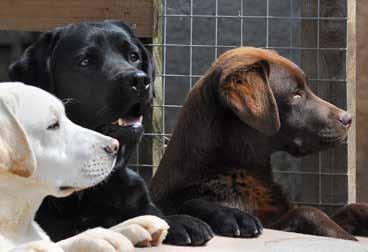
The data reveals that Labradors had similar levels of illness overall but went to the vet less often during the early months of the pandemic.
This highlights that dogs might not have received their usual veterinary care when they were ill. It is possible owners had difficulties accessing veterinary services or that they perceived their dogs’ ailments as too minor to treat in the circumstances, say researchers. The number of Labradors being vaccinated was down too, as a result of fewer vet visits.
Experts say the findings should prompt owners to speak to their vet and make sure any gaps in their dog’s vaccination history are addressed. They mention that future studies should aim to help veterinary professionals and owners minimise the negative impacts of a pandemic on dogs.
However, not all impacts of lockdown were negative. Just as some people stepped up their fitness routines, Labradors enjoyed an increase in exercise, and were less likely to be given treats by their owners.
Labrador owners also reported less coughing by their dogs, which might have included infectious causes like kennel cough – a perennial ailment in dogs. A reduction in dogs’ social interactions may have stemmed the spread of bugs, the team says
The team also found that, compared with previous years, Labradors were less likely to be insured, which may have been linked to the uncertain financial situation of many owners. Dogs in the study sample were, however, more likely to be wormed – most probably because owners were spending more time with their pets and less likely to forget.
The research was carried out as part of the Dogslife project, which investigates the genetic and environmental factors that keep dogs healthy.
Life changed for dogs during lockdown, study finds
Conservation
Veterinary science helps safeguard red squirrels
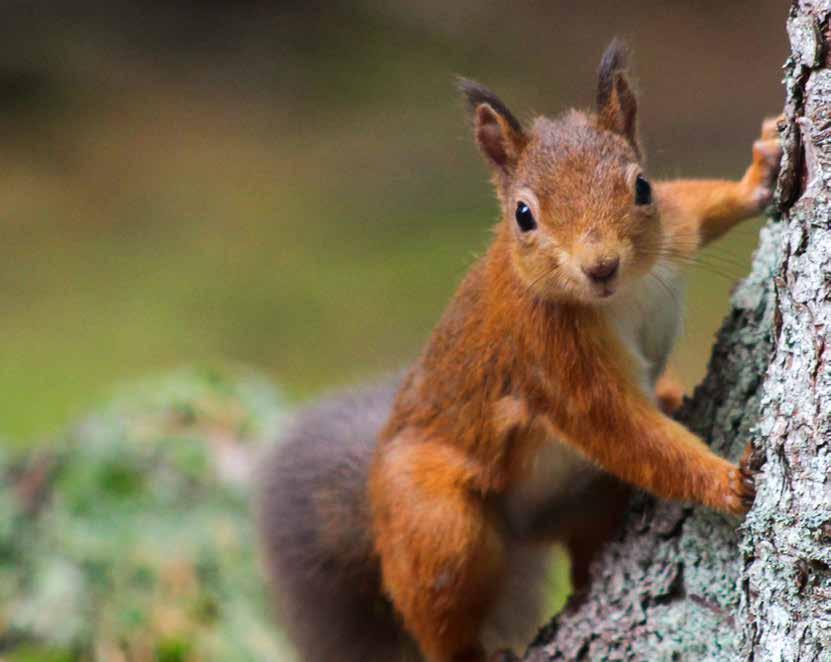
Experts at the Dick Vet are partnering with conservation and wildlife organisations to collect data on the health of red squirrels and monitor changes in diseases present in their population. The vet team’s efforts include a dedicated disease surveillance programme that identifies causes of death in the red squirrel population, whose numbers have declined significantly in recent years.
It does so by examining squirrel remains collected by members of the public, veterinary practices, wildlife rangers and conservation officers. The programme also monitors disease threats and enables early detection of new or emerging diseases that may affect the red squirrel population across the country. This information will help conservation and wildlife organisations direct their efforts and develop strategies to help protect red squirrels, one of the country’s most iconic and well-loved mammals.
It is estimated there are only 140,000 red squirrels remaining in the UK, 75 per cent of which are in Scotland. Numbers are declining due to loss of natural habitat, and competition for food and living space, following the introduction of non-native grey squirrels in the late 1800s. Grey squirrels also carry squirrel pox virus (SPV) which is lethal to reds but not to greys.
Veterinary pathologists at the School run the disease surveillance programme run the disease surveillance programme for Scottish red squirrels, which was established in 2005. They have conducted more than 700 post-mortem examinations on red squirrel carcasses.
“There is no doubt that squirrel pox virus is a serious threat to our native red squirrels in Scotland. However, there are a number of other health conditions, including leprosy, other viruses, and parasites that can also unfortunately result in their death, as well as the threat from road traffic. By offering a disease surveillance service we can build up a picture of the current health threats to Scotland’s red squirrels and identify disease incidence and patterns, which will help inform red squirrel conservation efforts.”
Professor Elspeth Milne, Veterinary Pathologist, Royal (Dick) School of Veterinary StudiesScotland hosts conservation genetics conference
The fifth annual European Conservation Genetics Meeting (ConsGen22) was held for the first time in Scotland from 30 August to 1 September 2022.
It was the first meeting of its kind in the UK and the hosts – the Royal Zoological Society of Scotland (RZSS), the University of Edinburgh and the Royal Botanic Garden Edinburgh (RBGE) – are recognised as global leaders in the fields of wildlife conservation and biodiversity research.
Experts shared recent developments in conservation genetics from around Europe and beyond in Edinburgh, a hub of science and innovation, as well as online, in this hybrid event.
The study of genetics is fundamental to species, the ecosystem, and for conservation. By understanding the genetic diversity within a population, experts can define what they are working with and how best to protect it.
Conservation genetics is a rapidly evolving field which is revolutionising species management and contributing to the conservation of some of the world’s most endangered wildlife. Scientists are ensuring that genetic tools and methods are available to conservationists working on a wide range of threatened species on the frontline of conservation around the world.
Risks to health impact on species reintroduction efforts
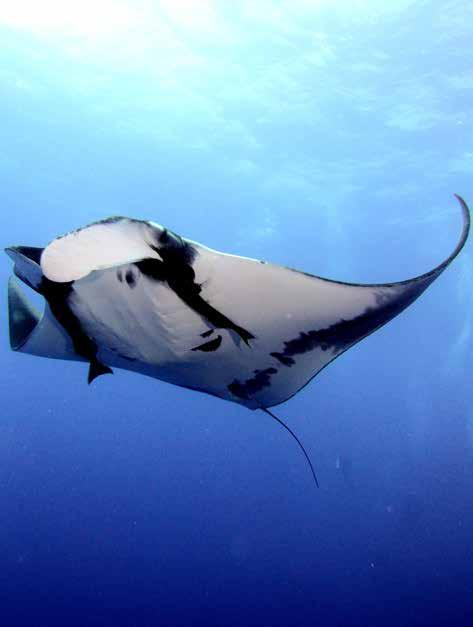
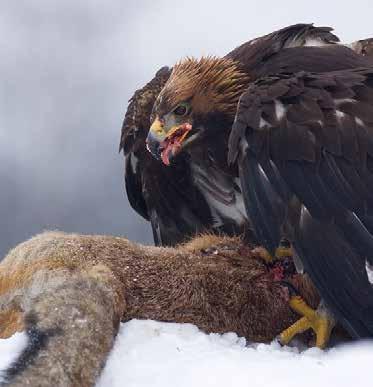
Wild species that are moved from one location to another for their conservation are often impacted by health issues as a result, a study of case reports has shown.
A team of researchers led by an expert from the Royal (Dick) School of Veterinary Studies and Roslin Institute assessed almost 300 case studies in which animal or plant species had been relocated in recent decades.
Diseases including infection, stress-related and husbandry-related disorders were found to be a significant issue in three cases out of 10. Two-thirds of the case studies experienced other biological problems, in particular predation, adverse climate or weather. Trauma owing to human-related activities was also commonly reported, especially after the release of species in their new location.
The findings highlight the need to consider health implications in the strategy and management of relocating plants and animals, according to scientists who did the research. They could influence reintroduction plans at a time when these are increasingly frequent, owing to loss of biodiversity and the impacts of climate change.
Relocating species can boost populations, reintroduce species, assist colonisation or facilitate ecological replacement, all of which can help to restore wildlife populations and their wider ecosystems.

